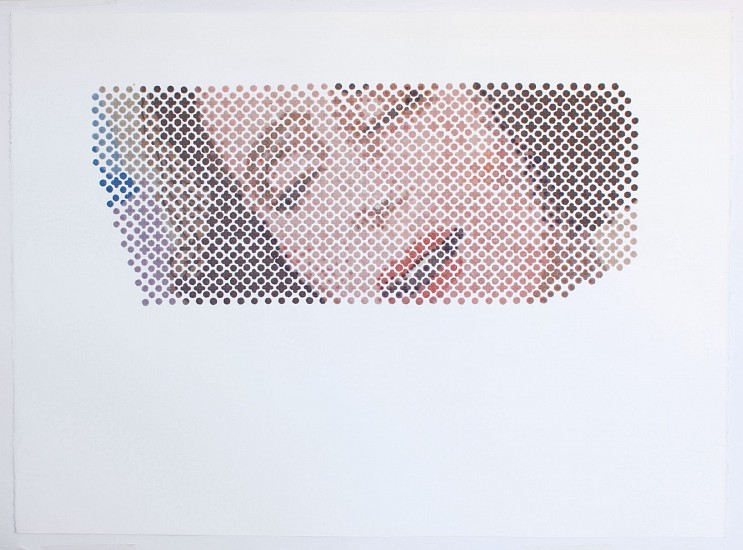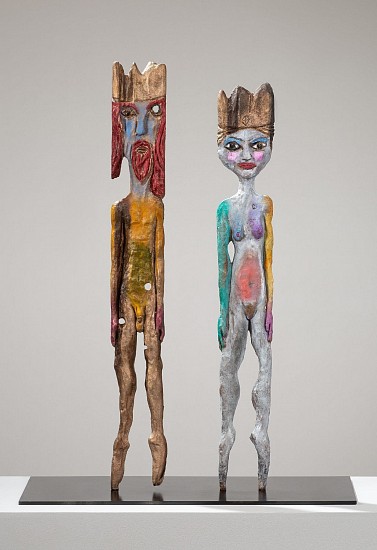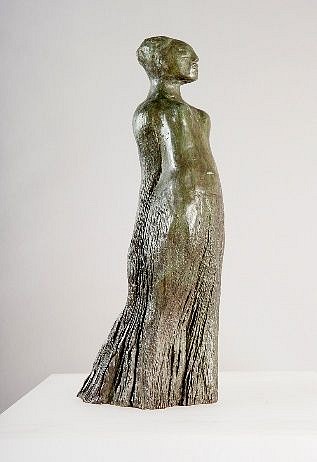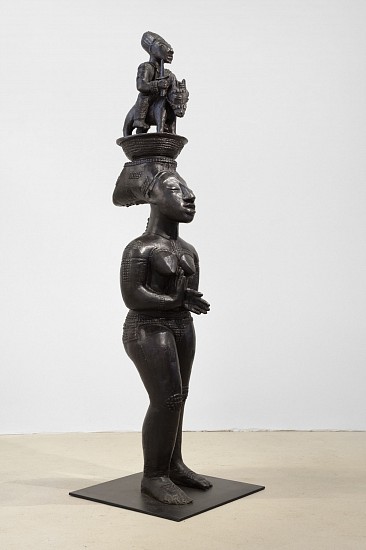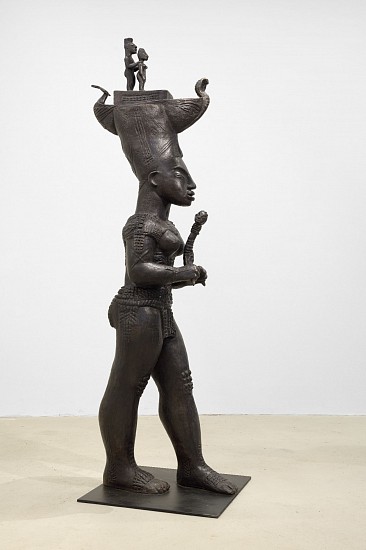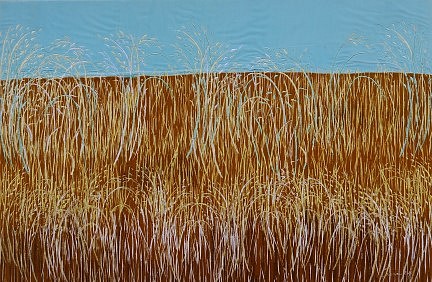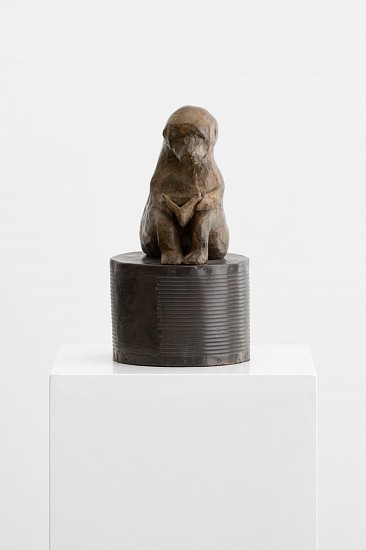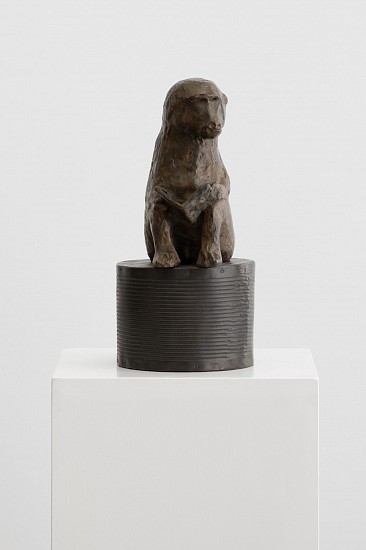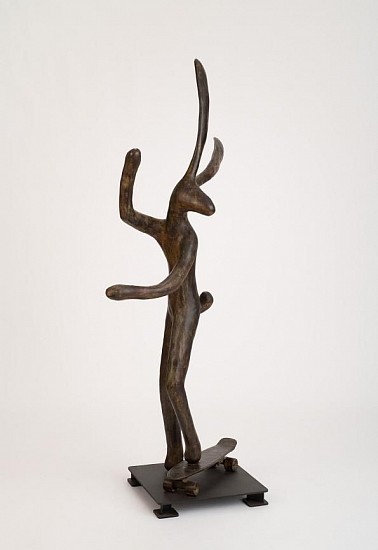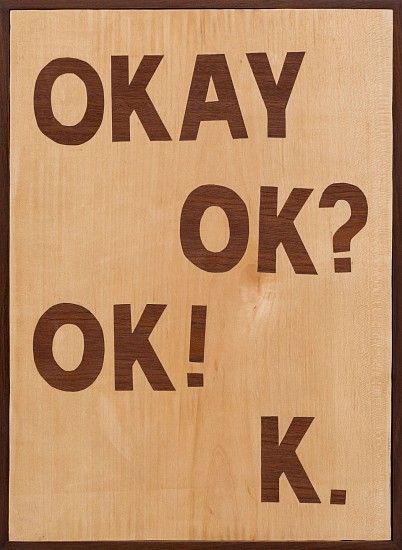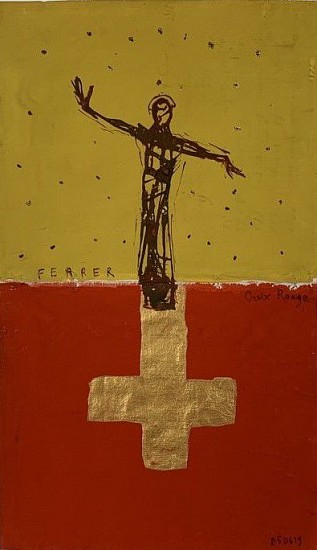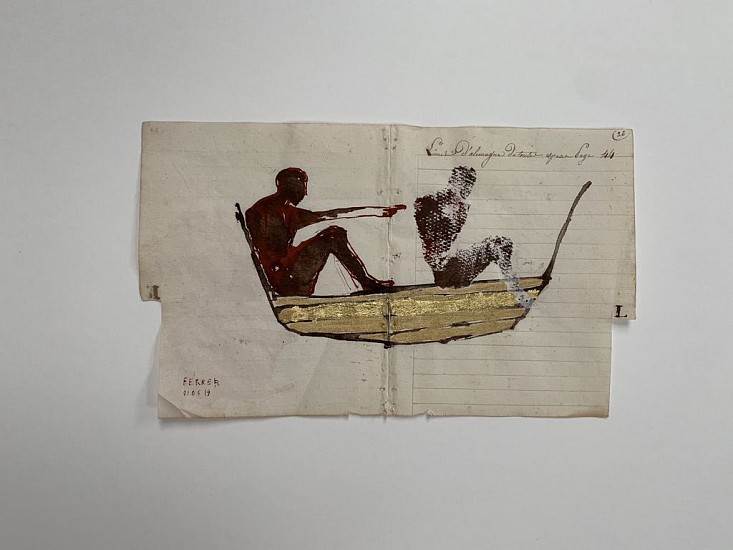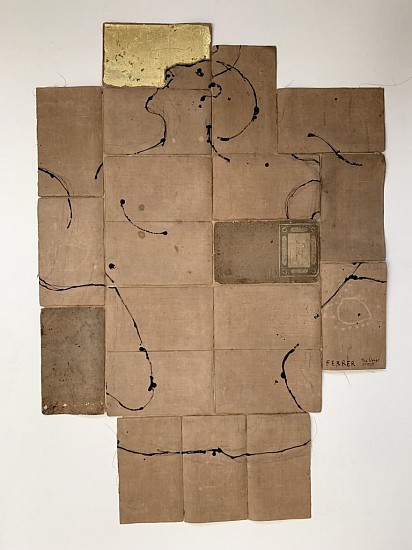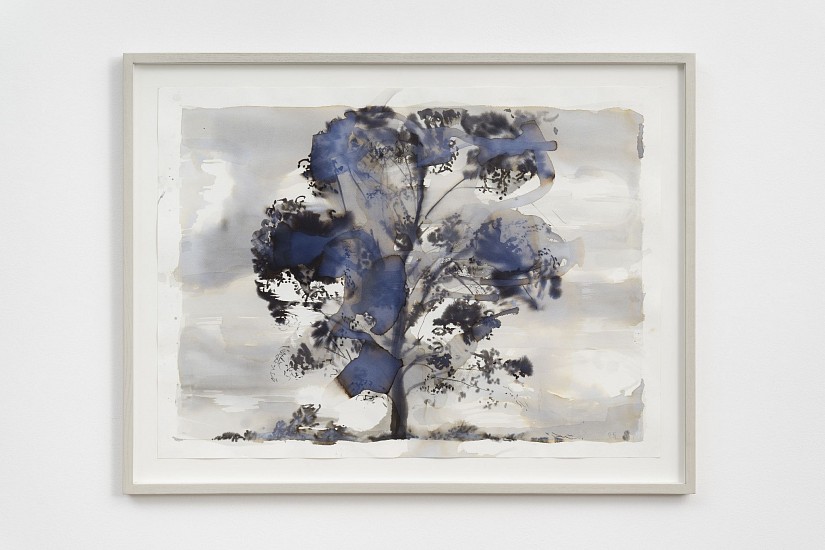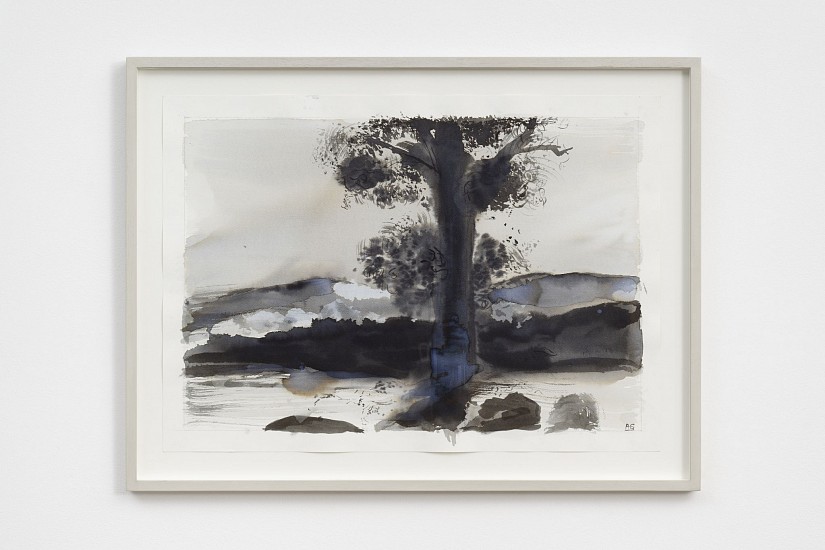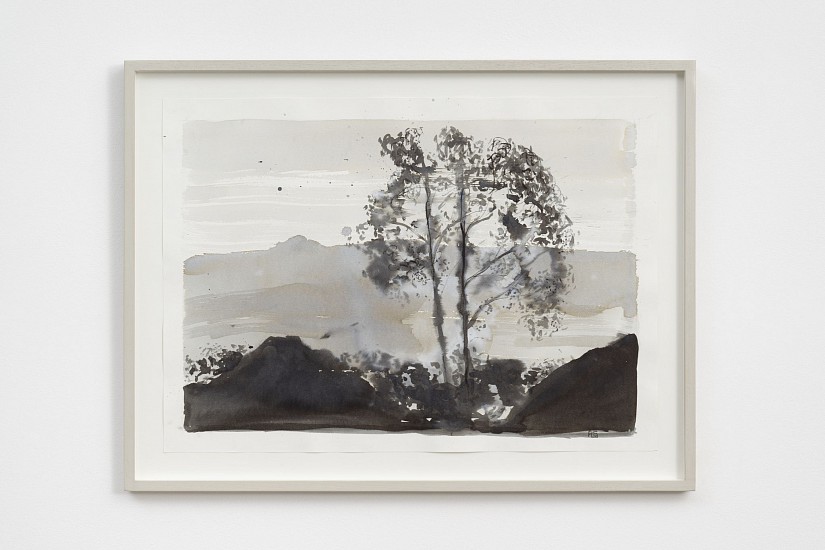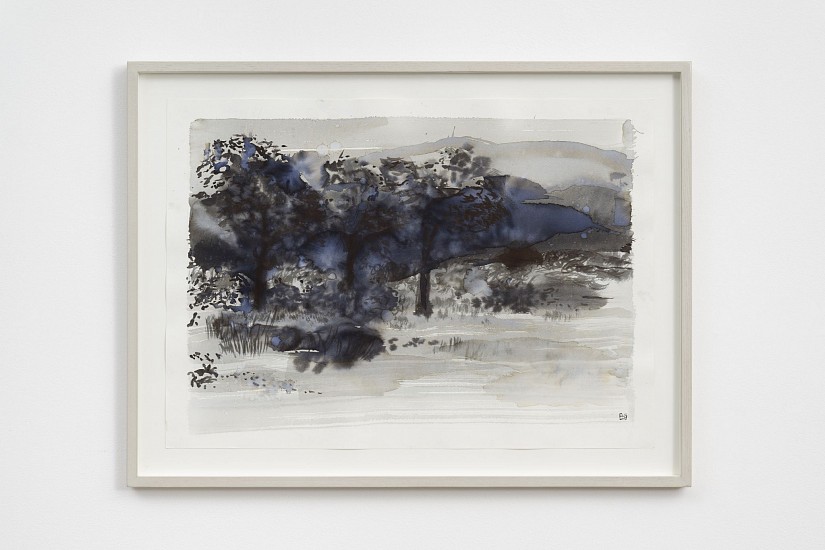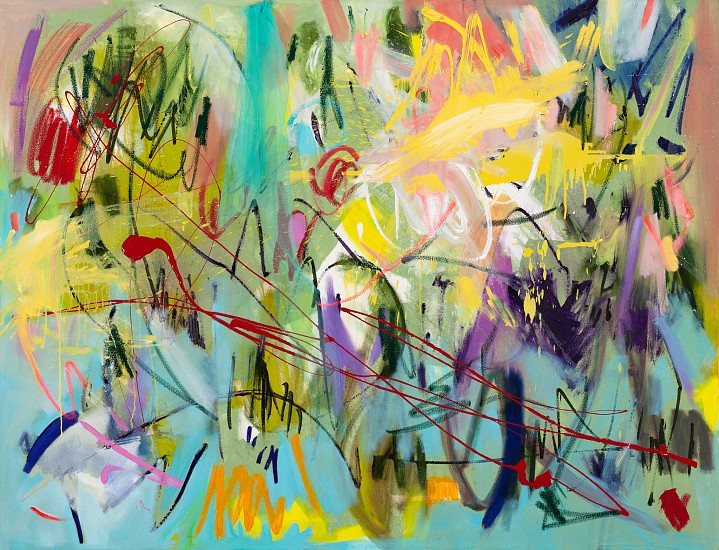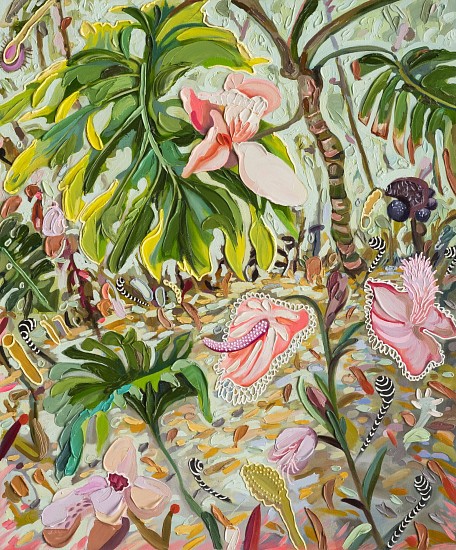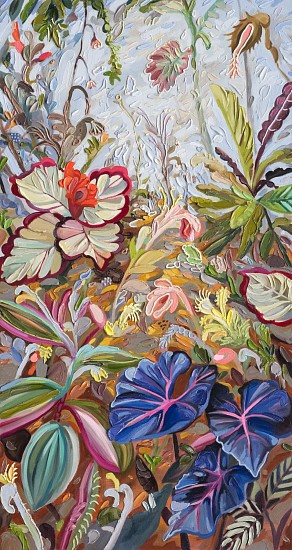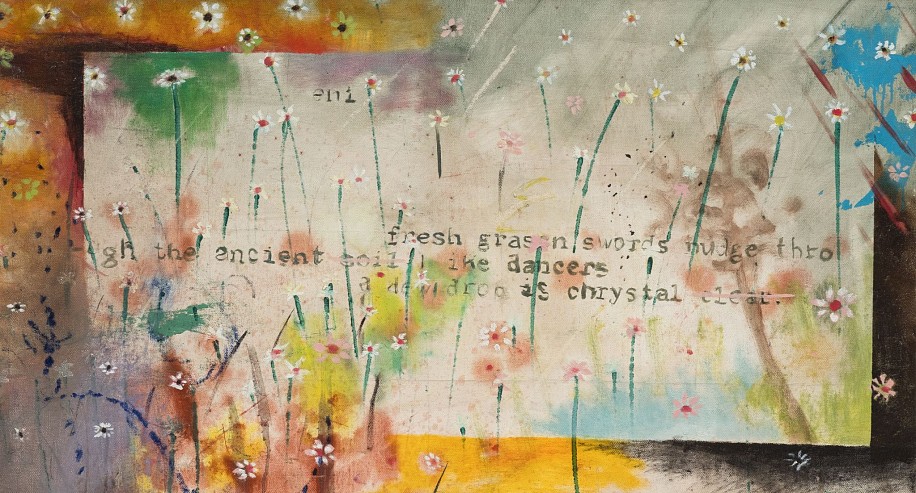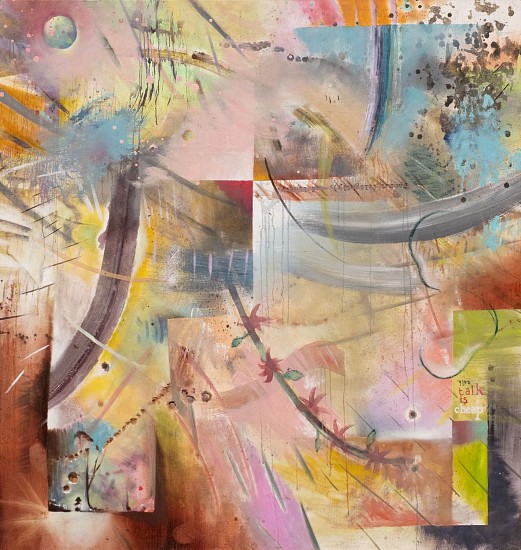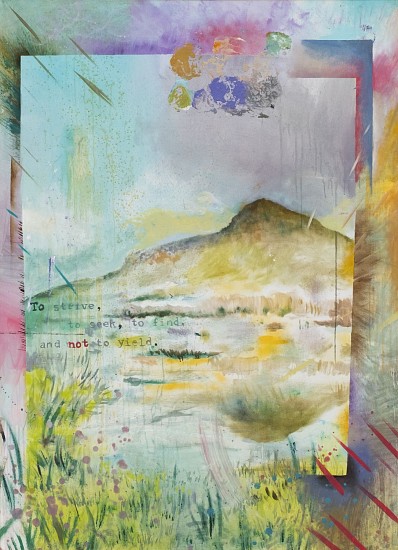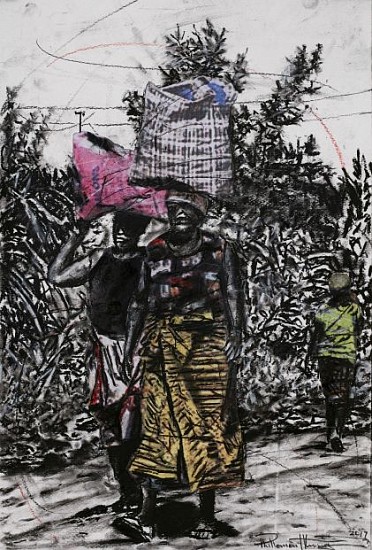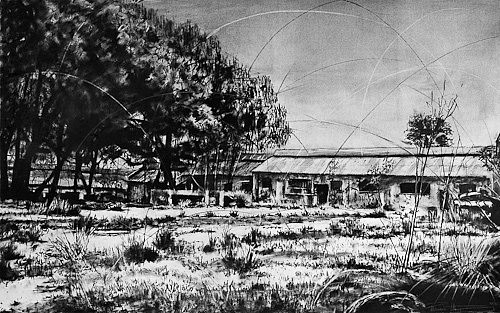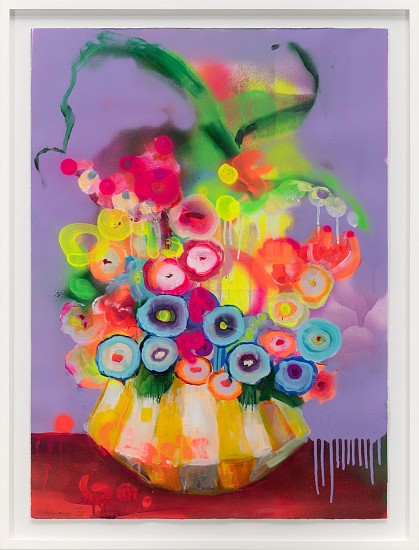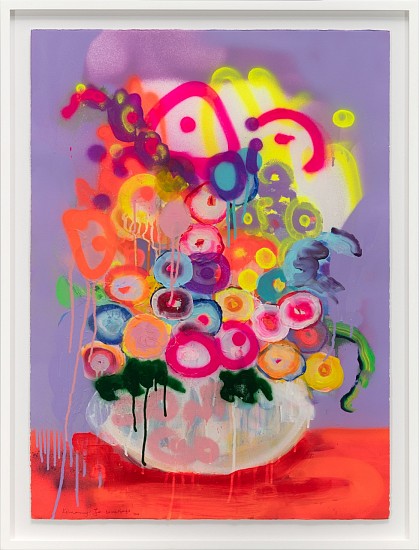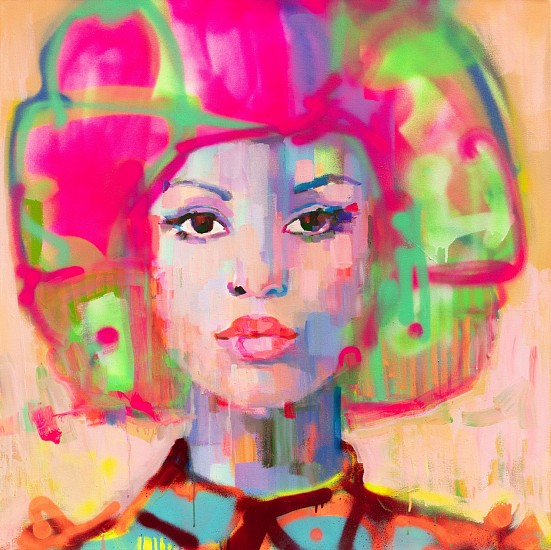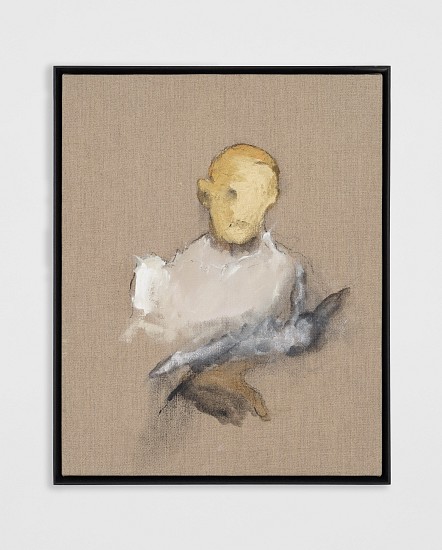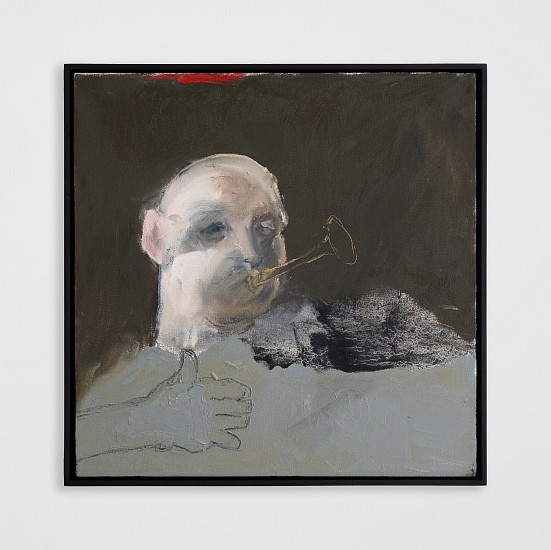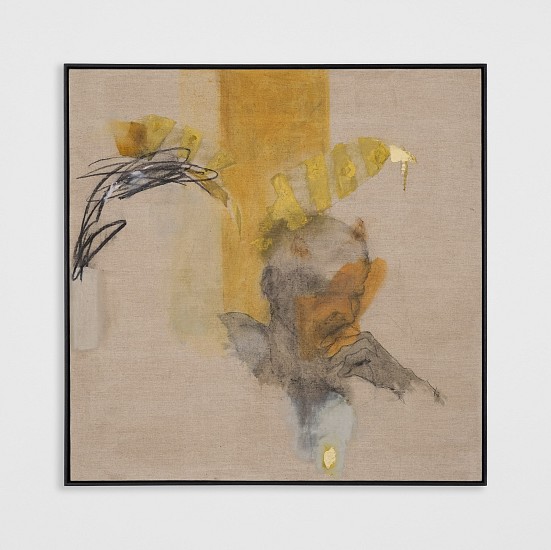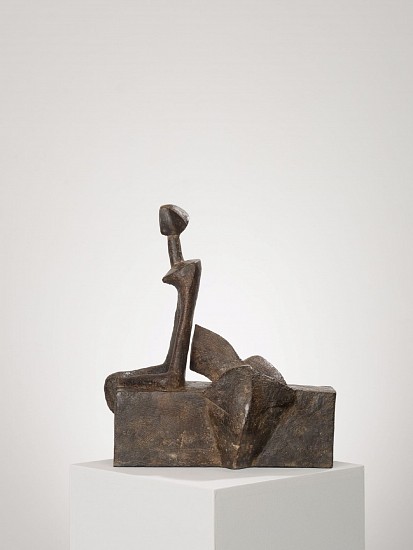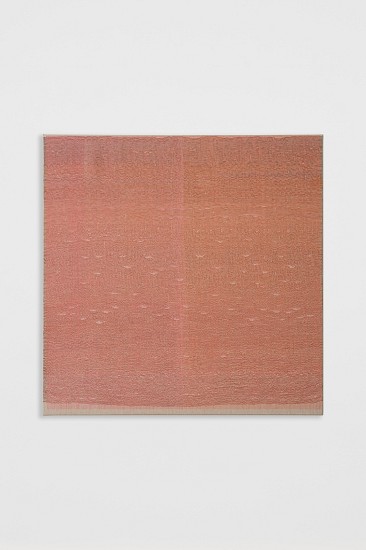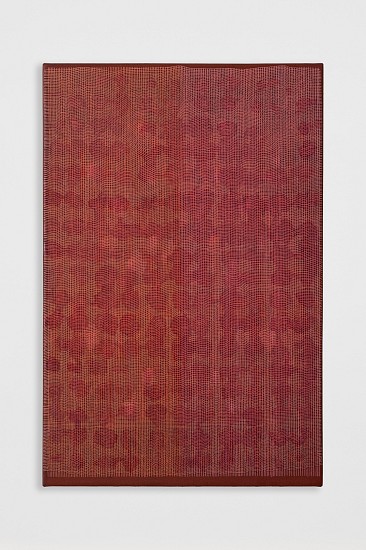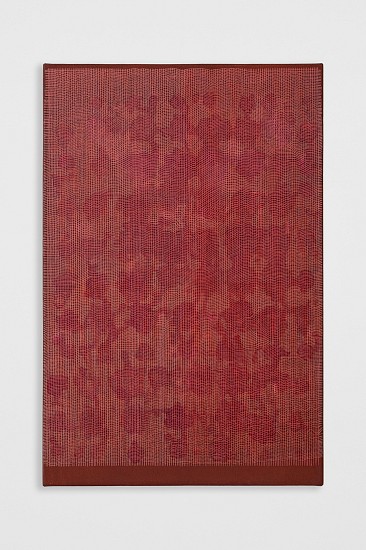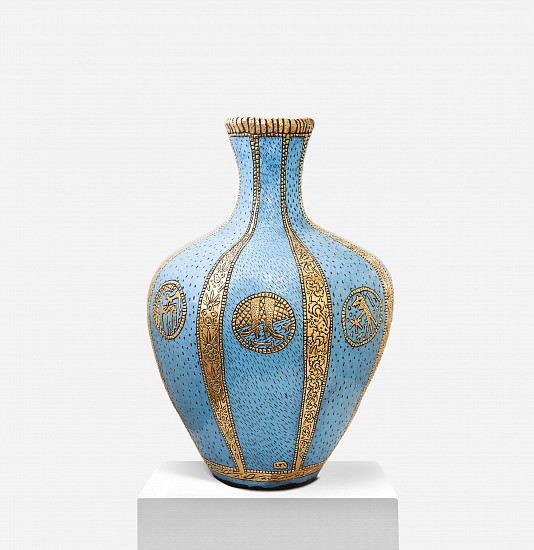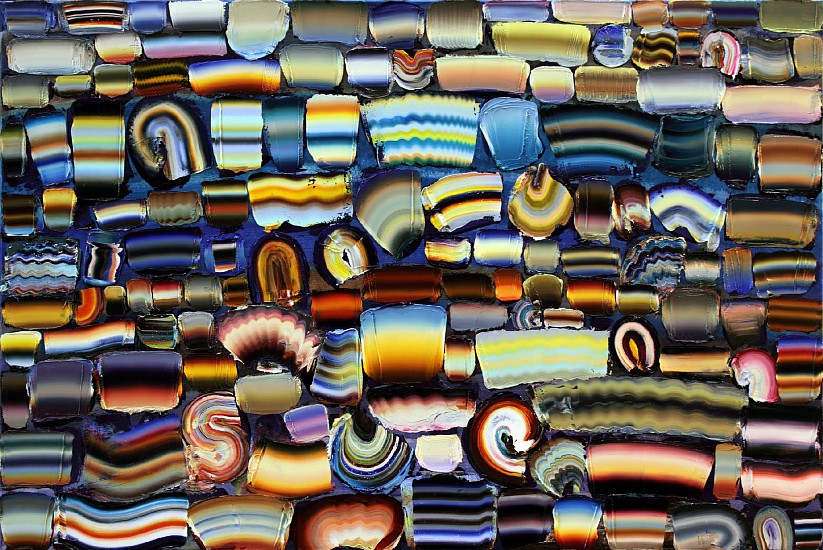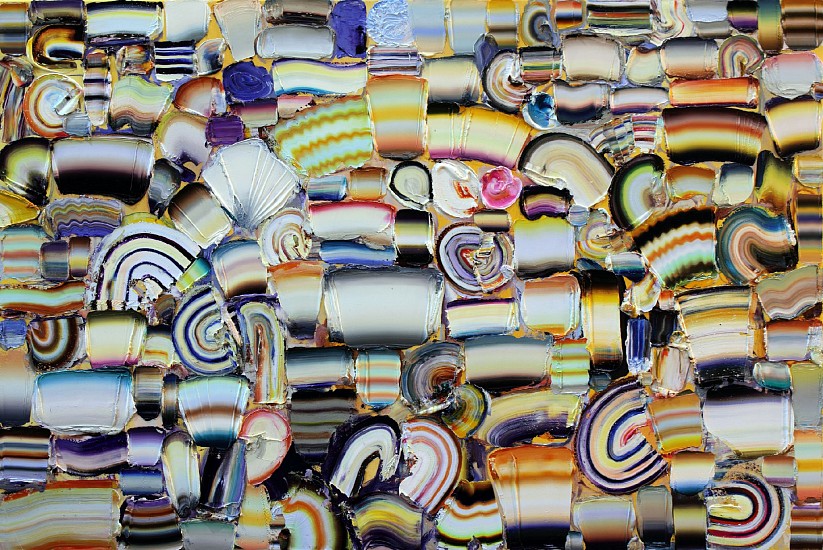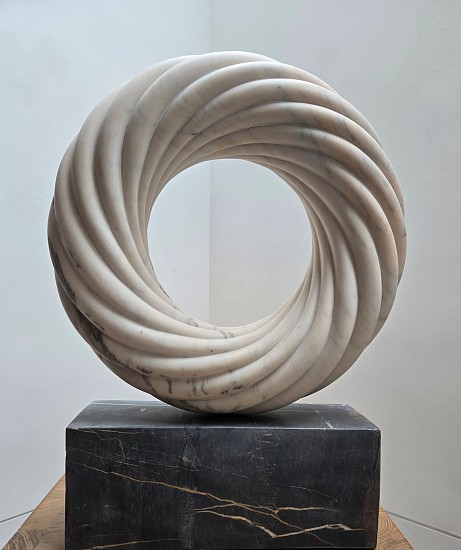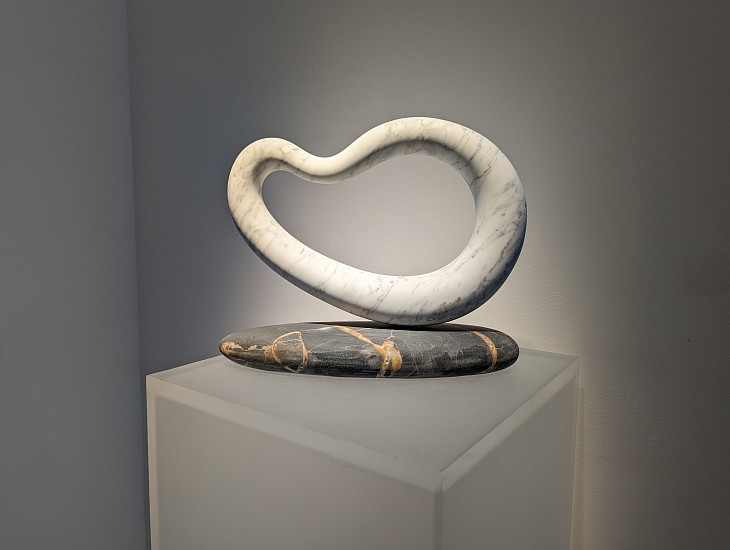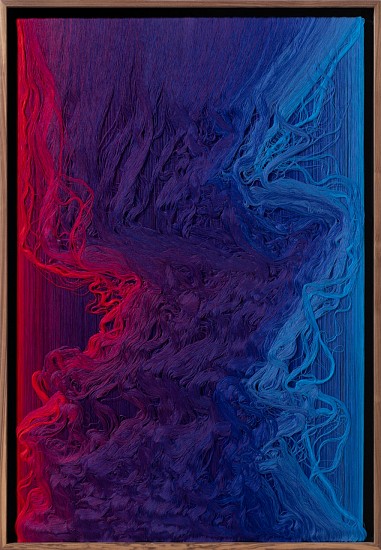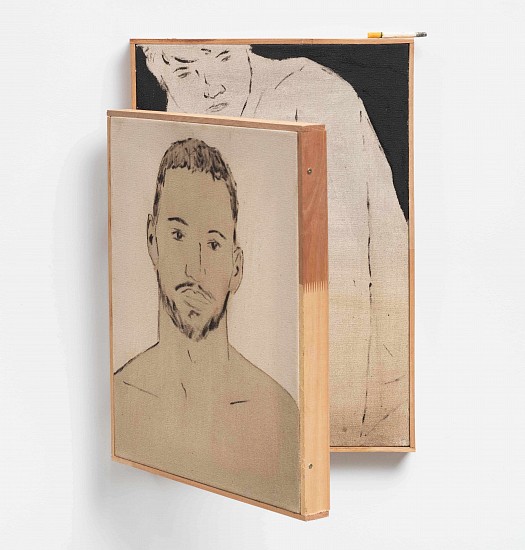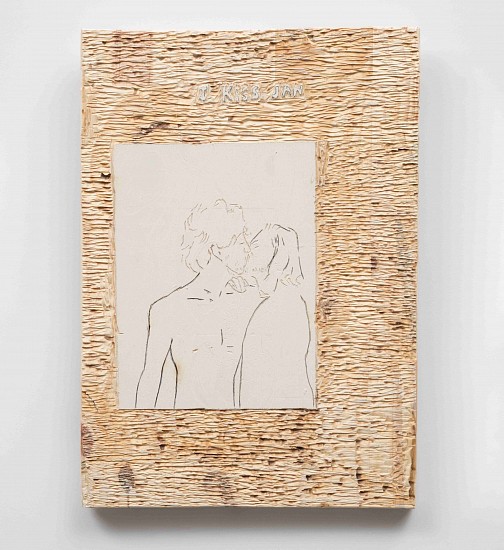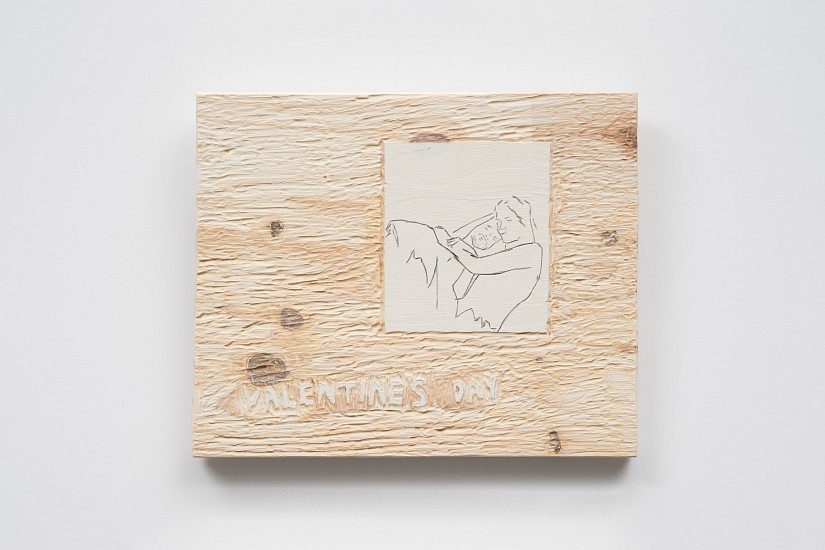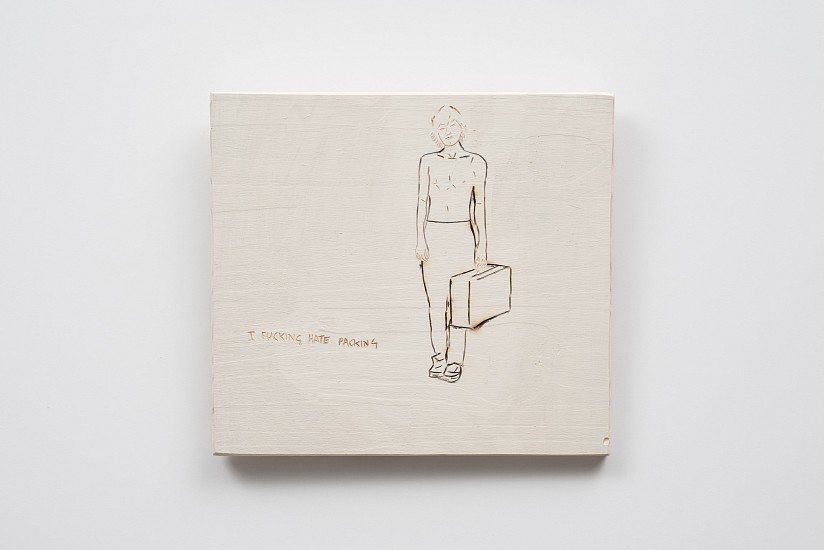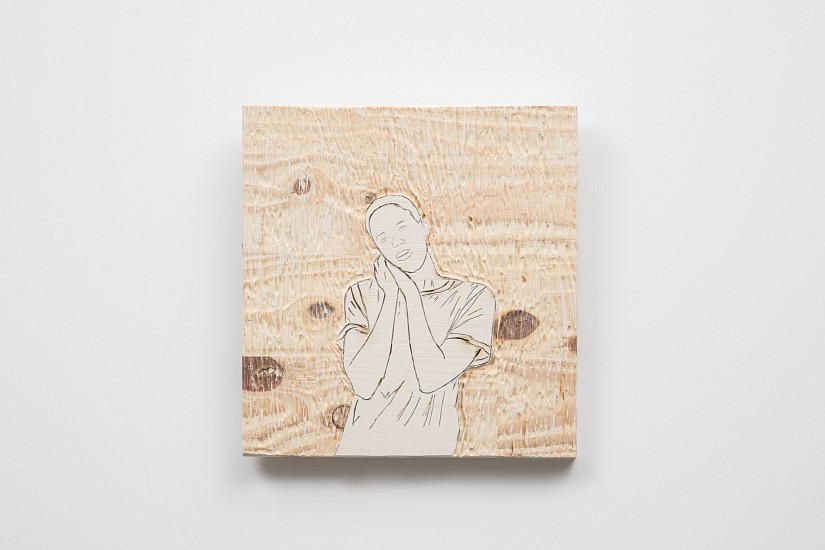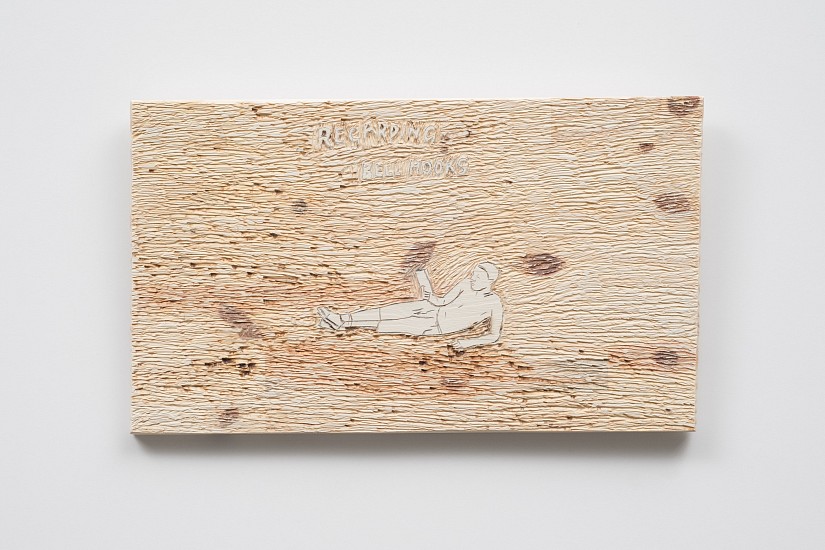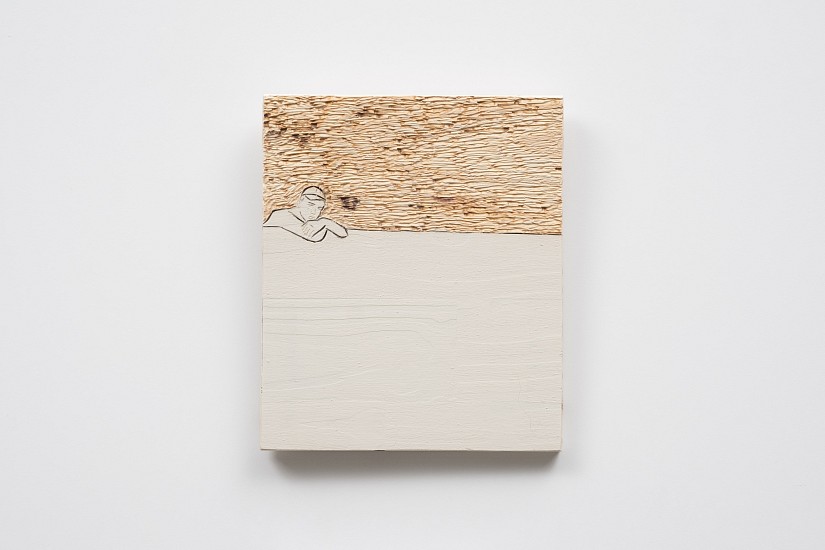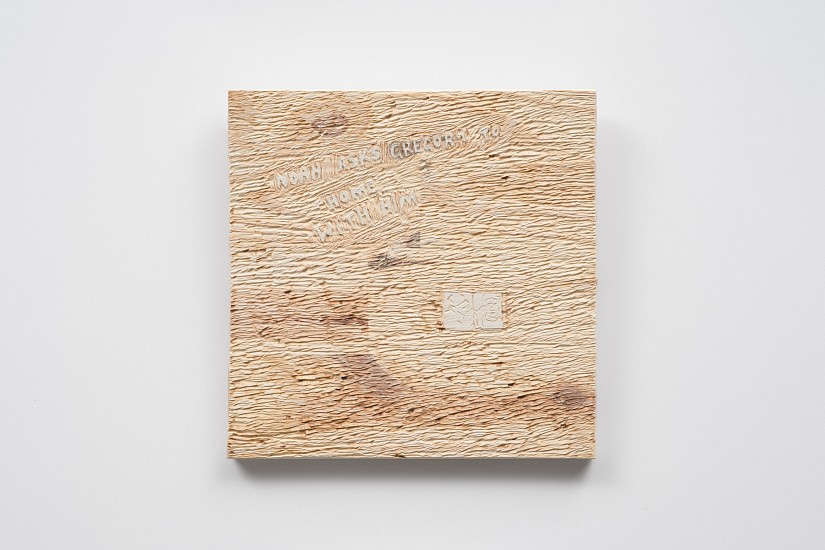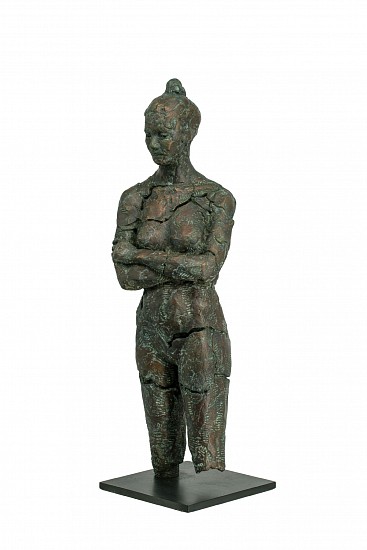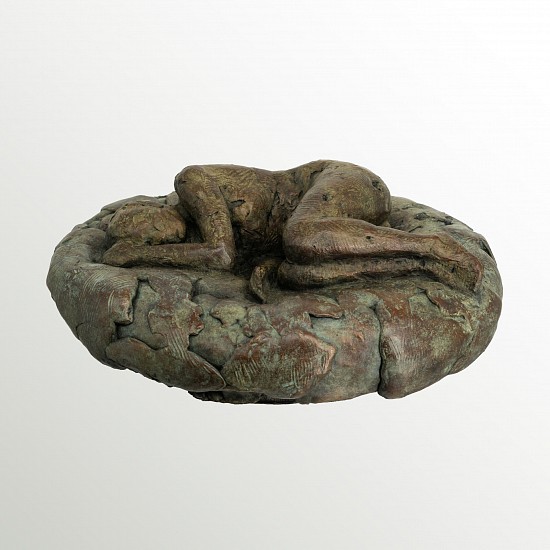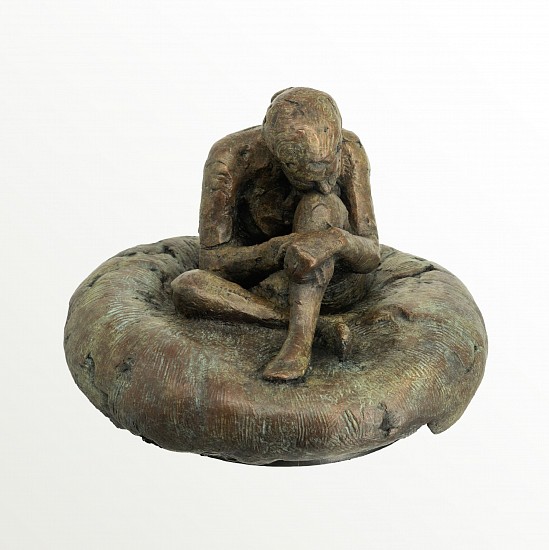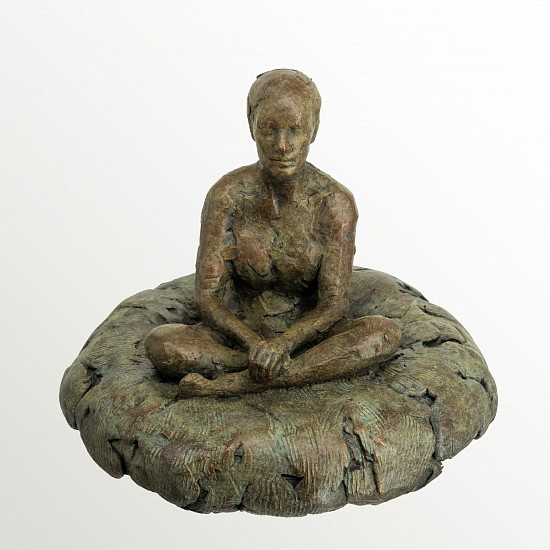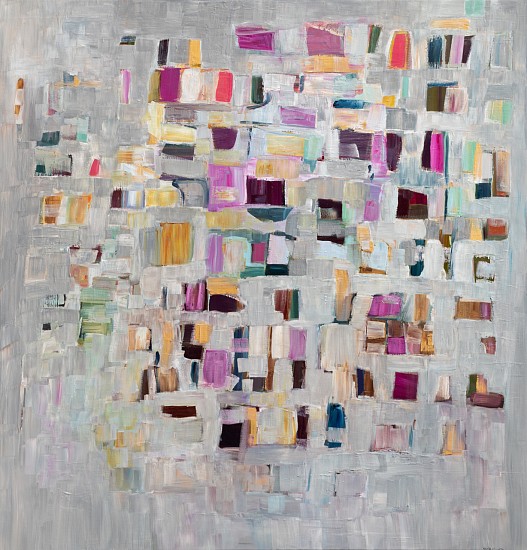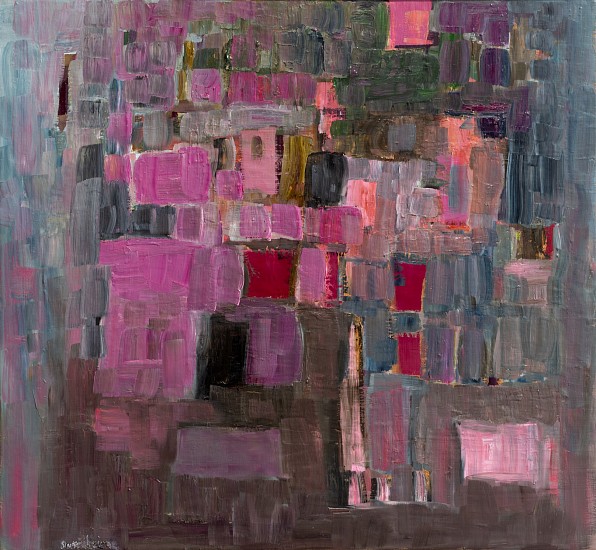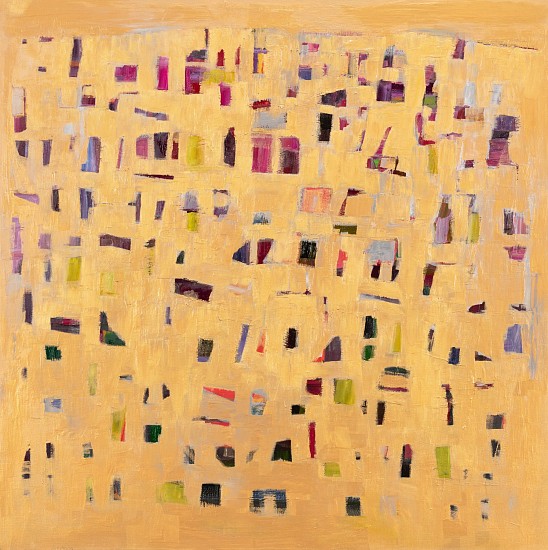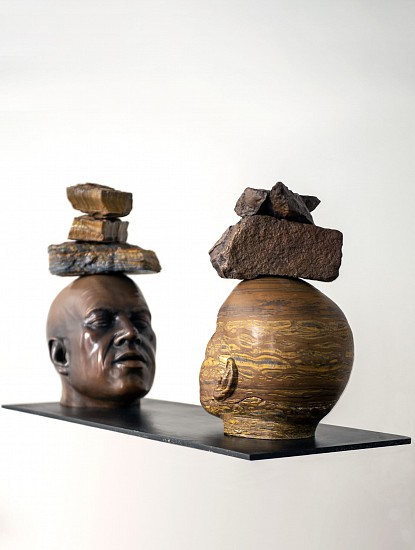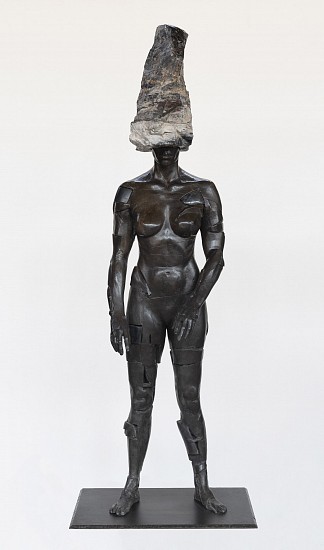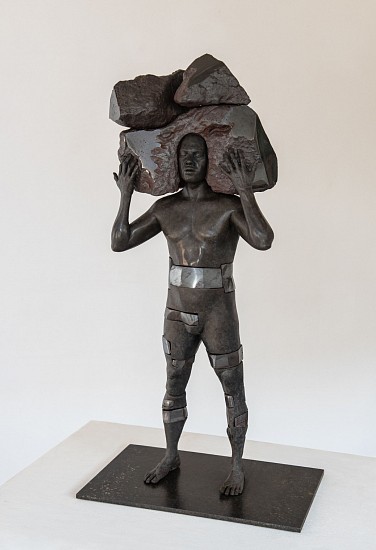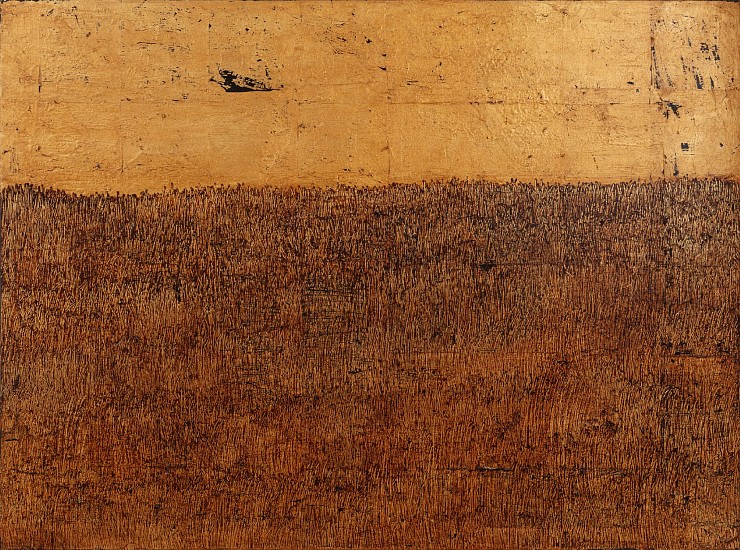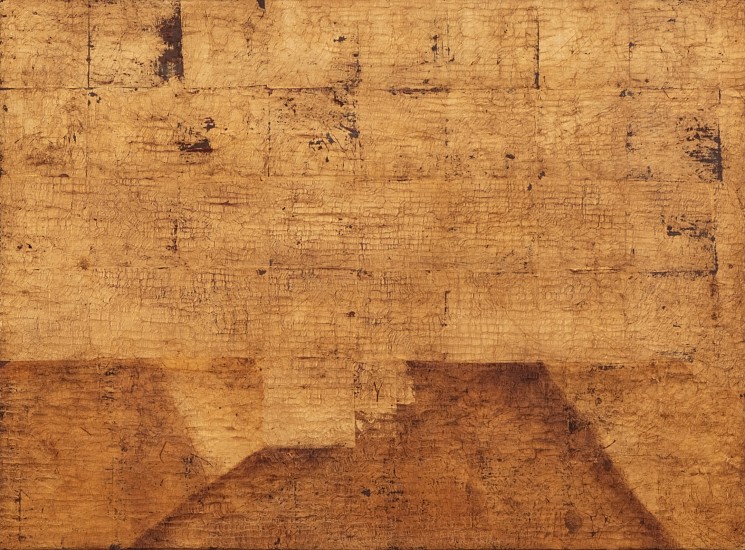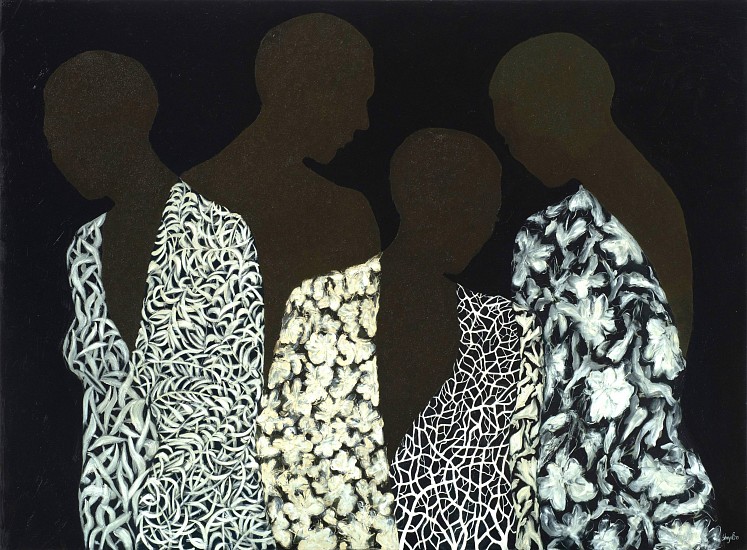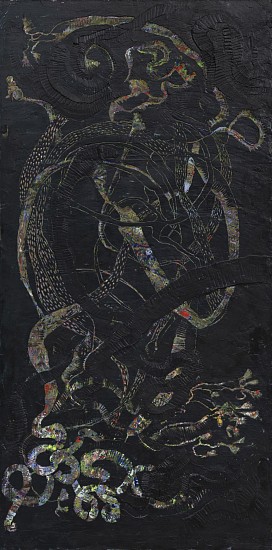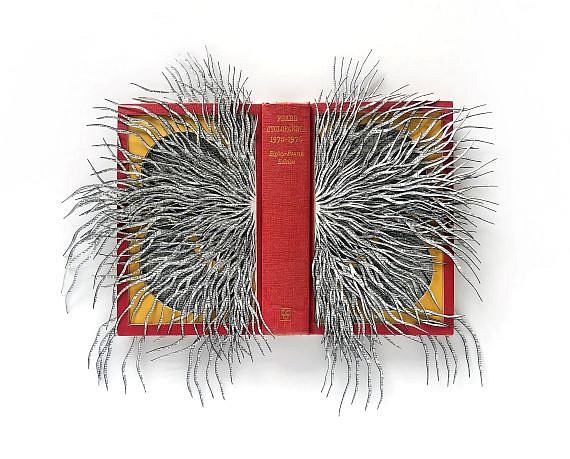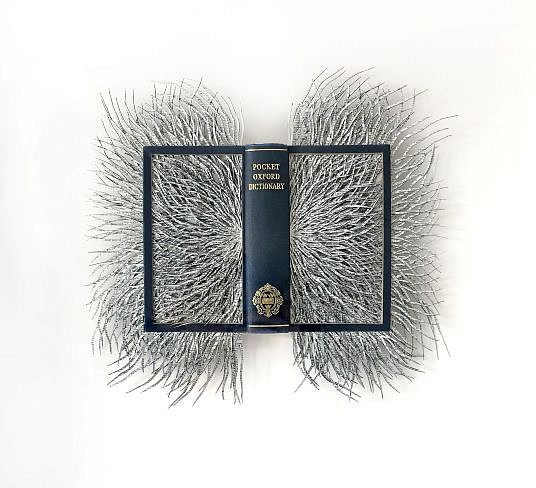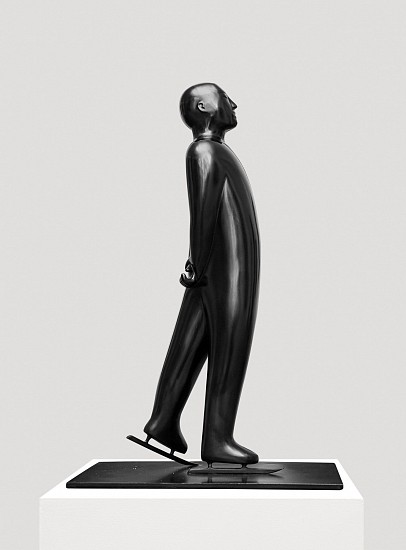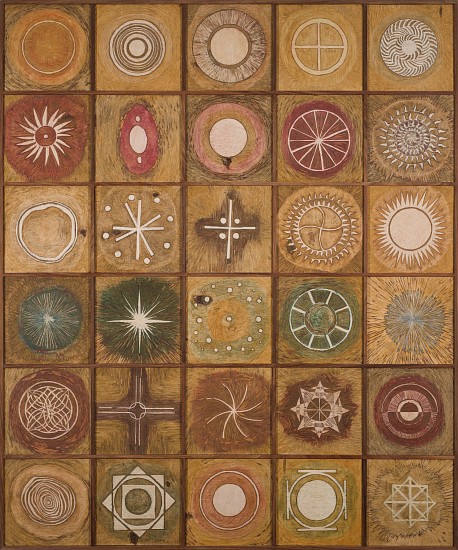MATTER MATTERS | ARTISTS & THEIR MEDIA
BONITA ALICE, Those Who Weep II
Woolen dust & archival glue on fabriano 300 gsm paper, 56 x 77 cm
Bonita Alice studied at the University of the Witwatersrand and the University of Cape Town in South Africa and taught in several Fine Art Departments until 2003. She spent 12 years in London before moving back to South Africa in 2020.
Alice’s studio practice reflects her interest in animal studies, a growing, global, crossdisciplinary field in which attempts are made to better understand human and animal relationships. Alice is particularly interested in aspects within psychology and psychoanalysis which she believes are useful in understanding the abuse of animals and the environment.
"These dust drawings are rooted in the central idea of psychoanalytic thought, that, even our most ordinary daily experience, we repress into the unconscious that which hurts us too much. The lattice form that gives structure to each image recalls the decorative screens of a confessional or harem; both places of theatricalised separation. The wool dust is a reference to transience, but also evokes something softened or cushioned, as if to protect the vulnerable."
– Bonita Alice



BEEZY BAILEY, King & Queen Maquette
Hand painted bronze, 104 x 40 x 5 cm
Beezy Bailey is a multi-disciplinary artist whose practice includes painting, sculpture, drawing, printmaking and ceramics.
He studied Fine Art at the Byam Shaw School of Art, in London (1983–86). Over a thirty-five-year career, he has exhibited in South Africa and internationally. In 2011 he had a solo exhibition at the Chenshia Museum in Wuhan, China; and in 2015 he was part of the official programme at the Venice Biennale. He has a history of close collaboration with other artists, most notably David Bowie, Brian Eno and Dave Matthews.
Bailey’s work is represented in important
art collections around the world, including the David Bowie Collection, the Getty Family Collection and the Oppenheimer Collection. His work is also in the permanent collections of Sasol, Standard Bank, Investec, the Kunsthaus Zurich, and the IZIKO South African National Gallery.
DEBORAH BELL, Meditations on a Tree
Bronze, 34 x 15.5 x 12 cm
Deborah Bell is one of South Africa’s most celebrated contemporary artists. She works in a range of media on canvas and paper, producing dry point etchings and large-scale bronzes.
Her earlier, more political work has given way to a broader, deeper investigation into the border between mortality and immortality, matter and spirit, presence and absence, the quotidian and the mythic, the grounded and transcendent. In recent years she has developed an immediately recognisable visual language, her images simple, stark, symbolic – grounded, silent, still, poised. In her iconography she draws from a range of cultures (including African, Chinese, Egyptian, Greek, early Christian and European) and a range of philosophies (especially the Buddhist preoccupation with stillness and the shedding of attachment and the ego) and psychologies (more Jung than Freud) – but her work digs deeper, arriving finally out of an internal and personal place that Bell occupies in the world as an artist, a woman and an explorer. A central task is to make the unknown present – apprehended in a series of powerful images that are both of her and beyond her.
Bell’s work is represented in public and private collections around the world including the Museum of Modern Art, New York, the Smithsonian Institute and the National Gallery of Art, Washington, DC, the Gloria Steinem Foundation, the Hara Museum, Tokyo and the IZIKO South African National Gallery, Cape Town.







DEBORAH BELL, Unearthed II
AP1
Bronze, 205 x 44 x 47 cm
Deborah Bell is one of South Africa’s most celebrated contemporary artists. She works in a range of media on canvas and paper, producing dry point etchings and large-scale bronzes.
Her earlier, more political work has given way to a broader, deeper investigation into the border between mortality and immortality, matter and spirit, presence and absence, the quotidian and the mythic, the grounded and transcendent. In recent years she has developed an immediately recognisable visual language, her images simple, stark, symbolic – grounded, silent, still, poised. In her iconography she draws from a range of cultures (including African, Chinese, Egyptian, Greek, early Christian and European) and a range of philosophies (especially the Buddhist preoccupation with stillness and the shedding of attachment and the ego) and psychologies (more Jung than Freud) – but her work digs deeper, arriving finally out of an internal and personal place that Bell occupies in the world as an artist, a woman and an explorer. A central task is to make the unknown present – apprehended in a series of powerful images that are both of her and beyond her.
Bell’s work is represented in public and private collections around the world including the Museum of Modern Art, New York, the Smithsonian Institute and the National Gallery of Art, Washington, DC, the Gloria Steinem Foundation, the Hara Museum, Tokyo and the IZIKO South African National Gallery, Cape Town.
AP1 | | Everard Read London







DEBORAH BELL, Unearthed VI
AP1
Bronze, 205 x 49 x 57 cm
Deborah Bell is one of South Africa’s most celebrated contemporary artists. She works in a range of media on canvas and paper, producing dry point etchings and large-scale bronzes.
Her earlier, more political work has given way to a broader, deeper investigation into the border between mortality and immortality, matter and spirit, presence and absence, the quotidian and the mythic, the grounded and transcendent. In recent years she has developed an immediately recognisable visual language, her images simple, stark, symbolic – grounded, silent, still, poised. In her iconography she draws from a range of cultures (including African, Chinese, Egyptian, Greek, early Christian and European) and a range of philosophies (especially the Buddhist preoccupation with stillness and the shedding of attachment and the ego) and psychologies (more Jung than Freud) – but her work digs deeper, arriving finally out of an internal and personal place that Bell occupies in the world as an artist, a woman and an explorer. A central task is to make the unknown present – apprehended in a series of powerful images that are both of her and beyond her.
Bell’s work is represented in public and private collections around the world including the Museum of Modern Art, New York, the Smithsonian Institute and the National Gallery of Art, Washington, DC, the Gloria Steinem Foundation, the Hara Museum, Tokyo and the IZIKO South African National Gallery, Cape Town.
AP1 | | Everard Read London


ARABELLA CACCIA, Liuwa Plains, Zambia, 2023
embroidery on hand painted velvet & chiffon, 76 x 115 cm
Although born in London, Caccia grew up in Tuscany before moving to Johannesburg, where she spent her teenage years. She studied at Edinburgh University and later lived and studied in Florence, London, and New York. In 1990, she returned to South Africa,
and now lives and works in Cape Town. Caccia draws inspiration from nature – from the unique light of her surroundings to the wilderness where she finds peace and silence. The sense of quiet and stillness in her work reflects the calm environment she cultivates to access her creativity
"My hope is that my art and the journey that has shaped it will inspire others to cultivate a playful curiosity about the natural world. I hope it encourages people to engage with nature in a way that nurtures their intuition, creativity, and sense of wonder. Through my work, I aim to invite others to experience nature with the same depth of appreciation I’ve been fortunate enough to encounter. May my creations serve as a bridge, connecting people to the beauty and magic of the natural world and fostering a deeper connection with the world around us.’
– Arabella Caccia
Caccia’s recent work explores patterns found in the interplay of light and dark on natural forms. Her paintings and sculptures employ an abstract language of semi-symbolic glyphs inspired by these patterns. Her work is fundamentally rooted in a belief in the importance of process. Using an ‘alphabet’ of glyphs derived from her study of nature, Caccia employs two- and three-dimensional mark-making to express a state of being.



WILMA CRUISE, Fossey
Bronze, 40 x 23 x 23 cm
Wilma Cruise works mainly with fired clay in her renderings of life-sized human and animal figures. Her sculpture installations and exhibitions are often accompanied by works on paper – large format drawings. She has also completed several series of print editions.
Themes explored in Cruise’s work include
the interface between humans and animals and existential conditions of muteness – silent, internal battles in the search for meaning.
Cruise has had over twenty solo exhibitions, curated others and completed a number of public works including the National Monument to the Women of South Africa at the Union Buildings, Pretoria and The Memorial to the Slaves in Cape Town in collaboration with Gavin Younge. Her work is represented in public, corporate and private collections throughout
South Africa. She has participated in the Havanna Biennale, the Florence Biennale and the prestigious 7th Gyeonggi International Ceramic Biennale in Seoul, Korea.
WILMA CRUISE, Goodall
Bronze, 44 x 25 x 22 cm
Wilma Cruise works mainly with fired clay in her renderings of life-sized human and animal figures. Her sculpture installations and exhibitions are often accompanied by works on paper – large format drawings. She has also completed several series of print editions.
Themes explored in Cruise’s work include
the interface between humans and animals and existential conditions of muteness – silent, internal battles in the search for meaning.
Cruise has had over twenty solo exhibitions, curated others and completed a number of public works including the National Monument to the Women of South Africa at the Union Buildings, Pretoria and The Memorial to the Slaves in Cape Town in collaboration with Gavin Younge. Her work is represented in public, corporate and private collections throughout
South Africa. She has participated in the Havanna Biennale, the Florence Biennale and the prestigious 7th Gyeonggi International Ceramic Biennale in Seoul, Korea.



GUY DU TOIT, On A Roll VII
Bronze, 190 x 90 x 50 cm
Guy du Toit’s apparent irreverence can obfuscate the fact that he is undoubtedly one of South Africa’s most accomplished sculptors. With the advent of democracy in South Africa, du Toit shifted his attention from notions of identity to pursuits such as revelling in form, concept and media for their own sake.
Du Toit graduated from the University of Pretoria with a BA (Fine Art) degree and a distinction in sculpture. He uses a wide range of media including bronze, stone, wood and steel, and draws in pen, ink and charcoal. He has exhibited extensively, both in his native South Africa and internationally, and has been consistently supported by private and public collectors, institutions, academics and fellow artists.
Honoured with several awards, du Toit curates and adjudicates exhibitions and lectures at several institutions, including Pelmama Academy in Soweto, Pretoria University, Johannesburg and Pretoria Technikon, and the Johannesburg School of Art, Ballet, Drama and Music. He gives workshops throughout South Africa and has been involved in community projects, seminars and symposia.


LUCA EVANS, Dialogue
maple, kiaat and sapele on pine, 42 x 35 x 4 cm
Luca Evans is a Cape Town-based artist working primarily with wood and text. Their work sits in a playful and delicate intersection between tradition and alteration, linguistics and visual art. They utilise a hit-and-miss experimental approach to woodwork. The ‘pop-ish’ work plays with
ideas around language, failure, mishap, violence, nostalgia and humour. Text and object are assembled interchangeably. Although they work predominantly with wood, their practice is intercepted with moments of print, animation and found objects.
In 2022 they co-founded Under Projects, an artist-run experimental project space where they work as a curator and programmer. They also lecture part-time in Conceptual and Curatorial practice. They have participated in a number of group exhibitions locally and internationally.



LUCA EVANS, Paradise Motel
birch, cherry, kiaat, maple, sapele and walnut on pine, 47 x 35 x 4 cm
Luca Evans is a Cape Town-based artist working primarily with wood and text. Their work sits in a playful and delicate intersection between tradition and alteration, linguistics and visual art. They utilise a hit-and-miss experimental approach to woodwork. The ‘pop-ish’ work plays with
ideas around language, failure, mishap, violence, nostalgia and humour. Text and object are assembled interchangeably. Although they work predominantly with wood, their practice is intercepted with moments of print, animation and found objects.
In 2022 they co-founded Under Projects, an artist-run experimental project space where they work as a curator and programmer. They also lecture part-time in Conceptual and Curatorial practice. They have participated in a number of group exhibitions locally and internationally.


GUY FERRER, Croix Rouge
Ink and gold leaf on antique paper, 29 x 17 cm (11 3/8 x 6 5/8 in.)
Born in Algeria, Guy Ferrer is a French artist of Catalan and Italian descent. Over the past three decades, Ferrer has developed an international reputation as a painter and sculptor, with exhibitions in museums and galleries around the world.
Ferrer’s work is fundamentally concerned with the mystery of life and the search of beauty. His artistic energy derives from a spiritual necessity to make art, as part on an ongoing search for transcendence, for solace and for meaning. Rich in symbolism and characterised by highly textured surfaces, Ferrer’s paintings, works on paper and sculptures are animated by his spirit and exude an ethereal energy. They connect at the deepest level with audiences across countries and cultures.
Recent honours include a monumental bronze for the French embassy in Singapore, a large fresco painted for the French embassy in Bakou, Azerbaijan and a triptych titled Liberté-Egalité-Fraternité commissioned by the OECD and for its headquarters in Paris. A monumental bronze and a large canvas are permanently installed at the main entrance of Le Bon Marché in Paris.




GUY FERRER, Double
Ink, collage and gold leaf on antique paper, 17 x 29 cm (6 5/8 x 11 3/8 in.)
Born in Algeria, Guy Ferrer is a French artist of Catalan and Italian descent. Over the past three decades, Ferrer has developed an international reputation as a painter and sculptor, with exhibitions in museums and galleries around the world.
Ferrer’s work is fundamentally concerned with the mystery of life and the search of beauty. His artistic energy derives from a spiritual necessity to make art, as part on an ongoing search for transcendence, for solace and for meaning. Rich in symbolism and characterised by highly textured surfaces, Ferrer’s paintings, works on paper and sculptures are animated by his spirit and exude an ethereal energy. They connect at the deepest level with audiences across countries and cultures.
Recent honours include a monumental bronze for the French embassy in Singapore, a large fresco painted for the French embassy in Bakou, Azerbaijan and a triptych titled Liberté-Egalité-Fraternité commissioned by the OECD and for its headquarters in Paris. A monumental bronze and a large canvas are permanently installed at the main entrance of Le Bon Marché in Paris.


GUY FERRER, The Upper
Gutta and gold leaf on antique paper, 93 x 65 cm (36 1/2 x 25 1/2 in.)
Born in Algeria, Guy Ferrer is a French artist of Catalan and Italian descent. Over the past three decades, Ferrer has developed an international reputation as a painter and sculptor, with exhibitions in museums and galleries around the world.
Ferrer’s work is fundamentally concerned with the mystery of life and the search of beauty. His artistic energy derives from a spiritual necessity to make art, as part on an ongoing search for transcendence, for solace and for meaning. Rich in symbolism and characterised by highly textured surfaces, Ferrer’s paintings, works on paper and sculptures are animated by his spirit and exude an ethereal energy. They connect at the deepest level with audiences across countries and cultures.
Recent honours include a monumental bronze for the French embassy in Singapore, a large fresco painted for the French embassy in Bakou, Azerbaijan and a triptych titled Liberté-Egalité-Fraternité commissioned by the OECD and for its headquarters in Paris. A monumental bronze and a large canvas are permanently installed at the main entrance of Le Bon Marché in Paris.


ANNE GRAAFF, Bluegum on Cedar Peak, Western Cape I
ink and wash on 300 gram watercolour paper, 66.3 x 86 cm
Anne Graaff is an artist, art historian and poet living in France, whose work is influenced by research on contemporary book art, and her own contribution to artist’s books. As an art historian, Graaff has specialized in Outsider Art, writing two books published by Penguin, South Africa, under the pseudonym, Anne Emslie. In 2017 Graaff republished The Owl House, a book about the renowned South African Outsider artist, Helen Martins.
Recent exhibitions of Graaff’s artist’s books and paintings include Elles métamorphosent le Livre II at Espace des Femmes gallery, Paris; a solo exhibition of artists books at Atelier de la Main d’Or, Paris; and work in the group shows at la Porte Peintre, France, as well as galleries in South Africa.
Graaff’s poetry has been published in numerous publications such as Carapace, Stanzas, the anthologies of African poetry, Africa, My Africa! and Absolute Africa! This is Graaff’s debut exhibition with the Everard Read galleries.


ANNE GRAAFF, Bluegum on Cedar Peak, Western Cape II
ink and wash on 300 gram watercolour paper, 60.6 x 80.3 cm
Anne Graaff is an artist, art historian and poet living in France, whose work is influenced by research on contemporary book art, and her own contribution to artist’s books. As an art historian, Graaff has specialized in Outsider Art, writing two books published by Penguin, South Africa, under the pseudonym, Anne Emslie. In 2017 Graaff republished The Owl House, a book about the renowned South African Outsider artist, Helen Martins.
Recent exhibitions of Graaff’s artist’s books and paintings include Elles métamorphosent le Livre II at Espace des Femmes gallery, Paris; a solo exhibition of artists books at Atelier de la Main d’Or, Paris; and work in the group shows at la Porte Peintre, France, as well as galleries in South Africa.
Graaff’s poetry has been published in numerous publications such as Carapace, Stanzas, the anthologies of African poetry, Africa, My Africa! and Absolute Africa! This is Graaff’s debut exhibition with the Everard Read galleries.


ANNE GRAAFF, Cedarberg Landscape, Western Cape I
ink and wash on 300 gram watercolour paper, 60.7 x 80.3 cm
Anne Graaff is an artist, art historian and poet living in France, whose work is influenced by research on contemporary book art, and her own contribution to artist’s books. As an art historian, Graaff has specialized in Outsider Art, writing two books published by Penguin, South Africa, under the pseudonym, Anne Emslie. In 2017 Graaff republished The Owl House, a book about the renowned South African Outsider artist, Helen Martins.
Recent exhibitions of Graaff’s artist’s books and paintings include Elles métamorphosent le Livre II at Espace des Femmes gallery, Paris; a solo exhibition of artists books at Atelier de la Main d’Or, Paris; and work in the group shows at la Porte Peintre, France, as well as galleries in South Africa.
Graaff’s poetry has been published in numerous publications such as Carapace, Stanzas, the anthologies of African poetry, Africa, My Africa! and Absolute Africa! This is Graaff’s debut exhibition with the Everard Read galleries.


ANNE GRAAFF, Cedar Peak Landscape, Western Cape, II
ink and wash on 300 gram watercolor paper, 60.2 x 80.4 cm
Anne Graaff is an artist, art historian and poet living in France, whose work is influenced by research on contemporary book art, and her own contribution to artist’s books. As an art historian, Graaff has specialized in Outsider Art, writing two books published by Penguin, South Africa, under the pseudonym, Anne Emslie. In 2017 Graaff republished The Owl House, a book about the renowned South African Outsider artist, Helen Martins.
Recent exhibitions of Graaff’s artist’s books and paintings include Elles métamorphosent le Livre II at Espace des Femmes gallery, Paris; a solo exhibition of artists books at Atelier de la Main d’Or, Paris; and work in the group shows at la Porte Peintre, France, as well as galleries in South Africa.
Graaff’s poetry has been published in numerous publications such as Carapace, Stanzas, the anthologies of African poetry, Africa, My Africa! and Absolute Africa! This is Graaff’s debut exhibition with the Everard Read galleries.


LIZA GROBLER, The Last Dance
Oil and mixed media on canvas, 130 x 170 cm
‘Reality is always shifting and, as an attempt to make sense of it, so am I.’
– Liza Grobler
After many years of living in Cape Town city centre, Liza Grobler now resides in Oudtshoorn in the Klein Karoo. As a compulsive constructor of alternative landscapes and realities, she explores ideas that bring together physical and psychological spaces and historical and ecological scapes. Her practice is built around process; creating a tension between the materiality and ephemerality of media. She invites the viewer to take a leap of faith and step into these constructive worlds alongside her.
Grobler is the recipient of a KANNA Award for her Visual Contribution to the Klein Karoo National Arts Festival (2023). In 2022, she was awarded the Centre Luigi di Sarro VAA Award (Italy) for her short film ‘Voices From a Divided Fountain’. In 2016, she was a recipient of the Africa Centre Award and Iziko Museums commissioned a site-specific work for the exhibition ‘Women’s Work’ at the South African National Gallery.
Liza Grobler’s paintings spill over with runaway scribbles and vigorous mark-making, their composition evoking morphing landscapes - perhaps echoing the artist’s own relocation from urban to rural - and the immediacy of their energetic brushstrokes and dribbles of paint harking back to Abstract Expressionism.
In Grobler’s words, “These landscapes are directly related to my recent body of work, Disobedient Landscapes, but the works point - at least in spirit - to the very tactile textures of the Klein Karoo.*
The most valuable lesson I have learnt from the Covid landscape is: 'the only constant is change'. And as I have always been preoccupied with the route, rather than the destination, the uncertainty of the present has brought about a heightened sense of awareness of our actions and environments. It is this quality that I wish to capture - momentous fractions of the present. We became aware of the temporal nature of all our 'securities' and in a sense this is liberating!
The work is also a final curtsy from my urban studio. For the past 20 years, the suburb of Woodstock, Cape Town has been my base camp. In May 2021, my family and I relocated to Oudtshoorn, the capitol of the Klein Karoo. It seems that the emotional shifts in our environment necessitated a physical shift too. This work marks the start of that journey.”
* The Klein Karoo is a semi-desert natural region of South Africa -the southern sibling of the larger Karoo - the Great or Groot Karoo.
Contact: info@everardlondon.com
Artist portrait: Frans Smit






LEE-ANN HEATH, Morning Cha-Cha
Oil on canvas, 120 x 100 cm
Lee-Ann Heath’s lush botanical paintings stem from her love of impasto and nature. Using her surroundings as a point of departure, Heath draws on inspiration both natural and relational. Heath’s goal is to recreate, analyse and deconstruct sensation.
When working with thick paint, the challenge of finding the balance between confident brush and palette knife strokes and moments of vulnerability, becomes integral to Heath’s process, with the continuous rearrangements of colours and forms lifting and enhancing each other, layer upon layer. The work reflects an obsessive urge to find the ‘right’ combination of colour, line and shape. As Heath explains: ‘I find the elements of surprise and unexpected accidental moments exciting, and when the accidental meets the intentional it often leads to the identity of the work coming into its own.’
Heath’s canvases have the distinctive mark of the artist’s hand; the thickly layered paint has been manipulated in a sensuous manner by her palms or fingers. This technique gives the images a three dimensional, almost culinary quality, the paint’s appearance reminiscent of icing on a cake – and almost good enough to eat. This invitation to an intense sensory interaction is carried through Heath’s practice, making her artworks textured, tactile and dynamic.





LEE-ANN HEATH, Under the Bloom
Oil on canvas, 150 x 80 cm
Lee-Ann Heath’s lush botanical paintings stem from her love of impasto and nature. Using her surroundings as a point of departure, Heath draws on inspiration both natural and relational. Heath’s goal is to recreate, analyse and deconstruct sensation.
When working with thick paint, the challenge of finding the balance between confident brush and palette knife strokes and moments of vulnerability, becomes integral to Heath’s process, with the continuous rearrangements of colours and forms lifting and enhancing each other, layer upon layer. The work reflects an obsessive urge to find the ‘right’ combination of colour, line and shape. As Heath explains: ‘I find the elements of surprise and unexpected accidental moments exciting, and when the accidental meets the intentional it often leads to the identity of the work coming into its own.’
Heath’s canvases have the distinctive mark of the artist’s hand; the thickly layered paint has been manipulated in a sensuous manner by her palms or fingers. This technique gives the images a three dimensional, almost culinary quality, the paint’s appearance reminiscent of icing on a cake – and almost good enough to eat. This invitation to an intense sensory interaction is carried through Heath’s practice, making her artworks textured, tactile and dynamic.




MATTHEW HINDLEY, Fresh Grass Swords
oil and acrylic on Italian Cotton, 50 x 92.5 cm
Matthew Hindley’s artistic focus has grown and developed from portraiture to abstraction and most recently the exploration of landscape. Over time subjects have developed from and continue to bleed into one another as Hindley hones his skills and builds experience.
A residency at the gardens and wetlands of Leeu Estates in Franschhoek, South Africa, provided inspiration for this new departure, and Hindley continues the series, exploring landscapes of personal significance to him: the view from his former studio, the road where he currently lives, the forest he and his daughter visited on holiday.
Hindley refers to these works as Memoryscapes – the scenes are laden with his personal memories as well as the significance assigned to them from the wider communities who treasure and protect the important places of outstanding natural beauty. Vibrant, luminous and teeming with life, the paintings do not claim ownership of the landscapes but rather proclaim an intense love for their subjects.



MATTHEW HINDLEY, Talk is Cheap
Oil on canvas, 150 x 140 cm
Matthew Hindley’s artistic focus has grown and developed from portraiture to abstraction and most recently the exploration of landscape. Over time subjects have developed from and continue to bleed into one another as Hindley hones his skills and builds experience.
A residency at the gardens and wetlands of Leeu Estates in Franschhoek, South Africa, provided inspiration for this new departure, and Hindley continues the series, exploring landscapes of personal significance to him: the view from his former studio, the road where he currently lives, the forest he and his daughter visited on holiday.
Hindley refers to these works as Memoryscapes – the scenes are laden with his personal memories as well as the significance assigned to them from the wider communities who treasure and protect the important places of outstanding natural beauty. Vibrant, luminous and teeming with life, the paintings do not claim ownership of the landscapes but rather proclaim an intense love for their subjects.



MATTHEW HINDLEY, To Strive
oil and acrylic on Italian Cotton, 133 x 95 cm
Matthew Hindley’s artistic focus has grown and developed from portraiture to abstraction and most recently the exploration of landscape. Over time subjects have developed from and continue to bleed into one another as Hindley hones his skills and builds experience.
A residency at the gardens and wetlands of Leeu Estates in Franschhoek, South Africa, provided inspiration for this new departure, and Hindley continues the series, exploring landscapes of personal significance to him: the view from his former studio, the road where he currently lives, the forest he and his daughter visited on holiday.
Hindley refers to these works as Memoryscapes – the scenes are laden with his personal memories as well as the significance assigned to them from the wider communities who treasure and protect the important places of outstanding natural beauty. Vibrant, luminous and teeming with life, the paintings do not claim ownership of the landscapes but rather proclaim an intense love for their subjects.
PHILLEMON HLUNGWANI, Amukela leswi u nga na swona u swi endla swa nkoka (Value what you have and be content with it) I
Charcoal and pastel on paper, 50 x 34 cm
Phillemon Hlungwani was born in Thomo Village, Giyani, in the Limpopo Province. He attended the local village schools, where he developed his skills under the guidance of his art teacher, and mentors Muxe Moses Mthombeni and Queen Mtileni. Hlungwani studied at the Johannesburg Art Foundation before studying printmaking under the mentorship of Kim Berman, the late Nhlahla Xaba and Osiah Masukameng at the Artist Proof Studio. Hlungwani later completed a teacher’s training course in Art at the WITS School of Art. He has since been based at the Artist Proof Studio, where he has facilitated classes, been a unit manager for papermaking, and was the coordinator for community outreach and special projects. He has also worked on a range of advisory and mentoring projects. Sponsored by the prestigious Ampersand Foundation Fellowship, Hlungwani completed an extensive study tour of printmaking studios in the United States. In addition to his drawing and graphic work, Hlungwani has completed and facilitated many murals, including at the Standard Bank Art Gallery (for the Picasso in Africa exhibition) and a mural for Bell Dewar and Hall. He has been commissioned by the Johannesburg Development Agencies, MTN and the South African Governmental offices.
Awards include the King Korn competition (2000 and 2001) and the SABC Radio Station Munghana Lonene FM Log Design Award (2003). He was a finalist in the Absa Gallery competition in 2001, 2002 and 2009.



PHILLEMON HLUNGWANI, Kule hi le ndzhaku II
(The past is the past, you cannot bring back the past with your money, it's impossible)
charcoal on paper, 75 x 118 cm
Phillemon Hlungwani was born in Thomo Village, Giyani, in the Limpopo Province. He attended the local village schools, where he developed his skills under the guidance of his art teacher, and mentors Muxe Moses Mthombeni and Queen Mtileni. Hlungwani studied at the Johannesburg Art Foundation before studying printmaking under the mentorship of Kim Berman, the late Nhlahla Xaba and Osiah Masukameng at the Artist Proof Studio. Hlungwani later completed a teacher’s training course in Art at the WITS School of Art. He has since been based at the Artist Proof Studio, where he has facilitated classes, been a unit manager for papermaking, and was the coordinator for community outreach and special projects. He has also worked on a range of advisory and mentoring projects. Sponsored by the prestigious Ampersand Foundation Fellowship, Hlungwani completed an extensive study tour of printmaking studios in the United States. In addition to his drawing and graphic work, Hlungwani has completed and facilitated many murals, including at the Standard Bank Art Gallery (for the Picasso in Africa exhibition) and a mural for Bell Dewar and Hall. He has been commissioned by the Johannesburg Development Agencies, MTN and the South African Governmental offices.
Awards include the King Korn competition (2000 and 2001) and the SABC Radio Station Munghana Lonene FM Log Design Award (2003). He was a finalist in the Absa Gallery competition in 2001, 2002 and 2009.
(The past is the past, you cannot bring back the past with your money, it's impossible) | | Everard Read London


KILMANY-JO LIVERSAGE, FLORA
acrylic, aerosol spray and marker on 300g Fabriano paper, 77 x 56 cm
Kilmany-Jo Liversage creates portraits that intentionally blur the boundary between fine art and street art. Her rendering of female subjects is inspired by Renaissance-era portraiture and, by adopting the language of graffiti or urban art, she updates, renews and challenges the conventions of painting. Her work also references digitised mass production and a futuristic post-human world, populated by perfect-looking female cyborgs. The result is a series of vivid, large-format paintings which evoke the street, the history of art and a vision of the future.
‘I feel strongly about the role women play in our society and am interested in portraying the strength and Femme fatalism of women in my portraits and still-lives. The role of matriarch has gained impetus through the digital age. Empowerment, transformation and a greater emphasis on gender-equality has created a global shift in how femininity is perceived and how contemporary women are portrayed.’


KILMANY-JO LIVERSAGE, PAFLORA
acrylic, aerosol spray and marker on 300g Fabriano paper, 77 x 56 cm
Kilmany-Jo Liversage creates portraits that intentionally blur the boundary between fine art and street art. Her rendering of female subjects is inspired by Renaissance-era portraiture and, by adopting the language of graffiti or urban art, she updates, renews and challenges the conventions of painting. Her work also references digitised mass production and a futuristic post-human world, populated by perfect-looking female cyborgs. The result is a series of vivid, large-format paintings which evoke the street, the history of art and a vision of the future.
‘I feel strongly about the role women play in our society and am interested in portraying the strength and Femme fatalism of women in my portraits and still-lives. The role of matriarch has gained impetus through the digital age. Empowerment, transformation and a greater emphasis on gender-equality has created a global shift in how femininity is perceived and how contemporary women are portrayed.’



KILMANY-JO LIVERSAGE, PORTRA
acrylic, aerosol spray and marker on canvas, 100 x 100 cm
Kilmany-Jo Liversage creates portraits that intentionally blur the boundary between fine art and street art. Her rendering of female subjects is inspired by Renaissance-era portraiture and, by adopting the language of graffiti or urban art, she updates, renews and challenges the conventions of painting. Her work also references digitised mass production and a futuristic post-human world, populated by perfect-looking female cyborgs. The result is a series of vivid, large-format paintings which evoke the street, the history of art and a vision of the future.
‘I feel strongly about the role women play in our society and am interested in portraying the strength and Femme fatalism of women in my portraits and still-lives. The role of matriarch has gained impetus through the digital age. Empowerment, transformation and a greater emphasis on gender-equality has created a global shift in how femininity is perceived and how contemporary women are portrayed.’






LORIENNE LOTZ, After Beuys - Explaining Peace
Oil and Charcoal on Linen , 50 x 40 cm
‘I continue to challenge the process of my artmaking and choice of materials by giving authority to the relevant poignant questions of our times and our very humanness.’
– Lorienne Lotz
Lorienne Lotz currently lives and works in Cape Town. She completed a Postgraduate Diploma in Fine Art at Michaelis UCT 2013. Lotz studied in the 1980’s under Bill Ainslie at the Johannesburg Art Foundation. Rose Shakinovsky and Claire Gavronsky (Rosenclaire’s) annual intensive workshops both in Italy and South Africa have been instrumental in her forging a deeply intuitive material process with an awareness of a formal language.
Lotz was awarded a Sasol New Signatures Merit Award 2014. Her work is held locally and internationally in private and public collections including the Spier Collection and Elllerman House in Cape Town.





LORIENNE LOTZ, Blowing His Own Trumpet
Oil and charcoal on canvas, 50 x 50 cm
‘I continue to challenge the process of my artmaking and choice of materials by giving authority to the relevant poignant questions of our times and our very humanness.’
– Lorienne Lotz
Lorienne Lotz currently lives and works in Cape Town. She completed a Postgraduate Diploma in Fine Art at Michaelis UCT 2013. Lotz studied in the 1980’s under Bill Ainslie at the Johannesburg Art Foundation. Rose Shakinovsky and Claire Gavronsky (Rosenclaire’s) annual intensive workshops both in Italy and South Africa have been instrumental in her forging a deeply intuitive material process with an awareness of a formal language.
Lotz was awarded a Sasol New Signatures Merit Award 2014. Her work is held locally and internationally in private and public collections including the Spier Collection and Elllerman House in Cape Town.





LORIENNE LOTZ, Our Better Angels
Oil and charcoal on canvas, 90 x 90 cm
‘I continue to challenge the process of my artmaking and choice of materials by giving authority to the relevant poignant questions of our times and our very humanness.’
– Lorienne Lotz
Lorienne Lotz currently lives and works in Cape Town. She completed a Postgraduate Diploma in Fine Art at Michaelis UCT 2013. Lotz studied in the 1980’s under Bill Ainslie at the Johannesburg Art Foundation. Rose Shakinovsky and Claire Gavronsky (Rosenclaire’s) annual intensive workshops both in Italy and South Africa have been instrumental in her forging a deeply intuitive material process with an awareness of a formal language.
Lotz was awarded a Sasol New Signatures Merit Award 2014. Her work is held locally and internationally in private and public collections including the Spier Collection and Elllerman House in Cape Town.


SPEELMAN MAHLANGU, Where we are at Now
Bronze, 40 x 32 x 13 cm
Mahlangu’s imagery is distinctly African and his work often encompasses a dreamworld with its roots in Ndebele tribal myths. His iconography draws on traditional practices inspired by his grandfather, who introduced him to the legends and symbolism of animals and ancestor sacrifice.
During his life, and following the end of apartheid, Mahlangu was profoundly interested in South Africa’s ‘homecoming’ to the African continent, and his work draws one into the realm of southern African icons of traditional life, depicted almost as hieroglyphics.






MAJA MARX, Dénouement
oil on Belgian Linen, 100 x 100 cm
Maja Marx's paintings are essentially hyperactivations of surface. Marx starts by mapping ‘found’ compositions onto her canvas, and then allows this process of transcription to self-proliferate. Once the optical field of each canvas has become alive, the artist uses the act of painting to literally ‘stare herself’ out onto the canvas. Each layer of paint, each engagement responds to the layers beneath to become rich self-referential fields in which the physical act of looking is foregrounded; surfaces that are read, looked at and stared into all at once.






MAJA MARX, Litmus
oil on Belgian Linen, 75 x 50 cm
Maja Marx's paintings are essentially hyperactivations of surface. Marx starts by mapping ‘found’ compositions onto her canvas, and then allows this process of transcription to self-proliferate. Once the optical field of each canvas has become alive, the artist uses the act of painting to literally ‘stare herself’ out onto the canvas. Each layer of paint, each engagement responds to the layers beneath to become rich self-referential fields in which the physical act of looking is foregrounded; surfaces that are read, looked at and stared into all at once.






MAJA MARX, Slow Fade to Blue
oil on Belgian Linen, 75 x 50 cm
Maja Marx's paintings are essentially hyperactivations of surface. Marx starts by mapping ‘found’ compositions onto her canvas, and then allows this process of transcription to self-proliferate. Once the optical field of each canvas has become alive, the artist uses the act of painting to literally ‘stare herself’ out onto the canvas. Each layer of paint, each engagement responds to the layers beneath to become rich self-referential fields in which the physical act of looking is foregrounded; surfaces that are read, looked at and stared into all at once.
LUCINDA MUDGE, Some People
Ceramic, gold lustre, 51 cm
Lucinda Mudge’s extraordinary vases captivate the eye with their rich colours and intricate detail. Yet beneath their glimmering
surfaces is a familiar world simmering with paranoia and tension.
Both a visual and a socio political record, her collection of vases draws inspiration from a wide variety of references, including cartoons, pop songs, fabric designs and Art Deco vase patterns, resulting in whimsical collisions of the popular and refined, the mundane and elevated, the violent and the beautiful. This range of contemporary and historical sources merges to present a complex narrative familiar to many South Africans.
Using hand mixed glazes and stains, and produced painstakingly slowly, each piece is as unique as the narrative it tells. Themes, images and text are repeated and reshuffled, embodying in their very fabric humanity’s ability to carry contradictory impulses simultaneously.



NIGEL MULLINS, Pragmatic, Jubilant, Organised
Oil on canvas, 100 x 150 cm (39 1/4 x 59 in.)
Nigel Mullins perceives his abstract works to be consoling and energizing structures. ‘These works are intended, at the simplest level, to activate a positive emotional state on entering the exhibition in a similar way to how stained glass windows in cathedrals may open one up to a state of contemplation,’ says Mullins. 'They do, however, also work as a positive visual metaphor for human endeavour [...] The act of compiling a series of colours and marks on a canvas is for me, a minimalist meditation on the nature of human constructs, both physical and social. The paintings, like culture, are the result of the accrual of choices, order, chaos and chance.’
Nigel Mullins has had numerous solo exhibitions in South Africa, the UK and Germany and has taken part in some 50 group shows. His work has been represented at the Cape Town, Johannesburg, Frankfurt and London art fairs and on the Mumia International Underground Animation Festival, Brazil. Mullins work is held in public and private collections in South Africa, the UK and Europe.
NIGEL MULLINS, Sublime Accrual of Mutable Aspirations
Oil on canvas, 100 x 150 cm (39 1/4 x 59 in.)
Nigel Mullins perceives his abstract works to be consoling and energizing structures. ‘These works are intended, at the simplest level, to activate a positive emotional state on entering the exhibition in a similar way to how stained glass windows in cathedrals may open one up to a state of contemplation,’ says Mullins. ‘They do, however, also work as a positive visual metaphor for human endeavour [...] The act of compiling a series of colours and marks on a canvas is for me, a minimalist meditation on the nature of human constructs, both physical and social. The paintings, like culture, are the result of the accrual of choices, order, chaos and chance.’
Nigel Mullins has had numerous solo exhibitions in South Africa, the UK and Germany and has taken part in some 50 group shows. His work has been represented at the Cape Town, Johannesburg, Frankfurt and London art fairs and on the Mumia International Underground Animation Festival, Brazil. Mullins work is held in public and private collections in South Africa, the UK and Europe.



WILLIAM PEERS, Cilia
Carrara marble, 95 x 71 x 17 cm
In the 1990s Peers moved to Cornwall and there followed a period of fifteen years where he exclusively carved relief sculptures in Hornton Stone. Over time, his work has become increasingly abstract. In 2007 he created a large series of work in Portuguese marble and the change of material had a dramatic effect on the style of his work.
Peers’ sculptures exist as a celebration of form and shape. The apparent weightlessness of his abstractions belie the intensive labour that creates the impossibly clean curves. It is as if the stone has absorbed Peers’ fierce concentration and infused the sculpture with energy and movement. Indeed, Peers believes that created objects hold in them, all the industry that went into their production; ‘Not just the attention that is paid them – but the intention.’
Imbued with this attention and intention, Peers’ works play on the juxtaposition of the unchanging, weighty nature of the stone and the airy movement so clearly present in the shapes Peers creates. More recently, the relationship between positive and negative shapes has become Peers’ focus. The focus is now not only on the marble contours, but on the air that surrounds them, a conversation between matter and space. It is this appreciation of the negative space that gives the works their defining sense of weightlessness.
Past exhibitions include seven solo exhibitions with John Martin Gallery as well as exhibitions in New York and San Francisco. Public exhibitions include On Form at Asthall Manor, Woburn Abbey and Glyndebourne. Two of Peers monumental sculptures are permanently displayed at Linthwaite House in Britain’s Lake District as part of the Leeu Hotel Group’s collection.


WILLIAM PEERS, Orgos
Carrara marble, 32 x 37 x 7 cm (12 1/2 x 14 1/2 x 2 3/4 in.)
In the 1990s Peers moved to Cornwall and there followed a period of fifteen years where he exclusively carved relief sculptures in Hornton Stone. Over time, his work has become increasingly abstract. In 2007 he created a large series of work in Portuguese marble and the change of material had a dramatic effect on the style of his work.
Peers’ sculptures exist as a celebration of form and shape. The apparent weightlessness of his abstractions belie the intensive labour that creates the impossibly clean curves. It is as if the stone has absorbed Peers’ fierce concentration and infused the sculpture with energy and movement. Indeed, Peers believes that created objects hold in them, all the industry that went into their production; ‘Not just the attention that is paid them – but the intention.’
Imbued with this attention and intention, Peers’ works play on the juxtaposition of the unchanging, weighty nature of the stone and the airy movement so clearly present in the shapes Peers creates. More recently, the relationship between positive and negative shapes has become Peers’ focus. The focus is now not only on the marble contours, but on the air that surrounds them, a conversation between matter and space. It is this appreciation of the negative space that gives the works their defining sense of weightlessness.
Past exhibitions include seven solo exhibitions with John Martin Gallery as well as exhibitions in New York and San Francisco. Public exhibitions include On Form at Asthall Manor, Woburn Abbey and Glyndebourne. Two of Peers monumental sculptures are permanently displayed at Linthwaite House in Britain’s Lake District as part of the Leeu Hotel Group’s collection.





MARK RAUTENBACH, Gentian (Ad Hominem Series), 2023
Mixed media, 127.5 x 88.5 cm
Rautenbach works in a variety of media, including material which is considered waste matter, as well as textiles and paper. His practice is often process-based, and draws on traditional craft techniques.
The textural languages he uses guides his creative procedures by inviting consideration of their inherent potential and associations. Through ritualistic repetition – drawing on the arcane and everyday, the collective and personal – Rautenbach uses his meditative works to embody psychological and cultural patterns, giving form to invisible spaces. Physical conglomerations – whether of thread, steel safety pins or glass – symbolise emotional connections.
By renegotiating found objects and materials from shops, recycle bins, gifts and disassembled artworks, Rautenbach manifests forms which exhibit his alchemical journey: his commitment to be present with all things even when they are uncomfortable. To delve into, uncover, bind and cocoon his being – to transform into something beyond expectations.



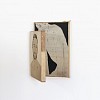


BRETT CHARLES SEILER, Fabio Resting on Callum's Chest (Diptych)
bitumen and roof paint on canvas, 62 x 42 x 9 cm
"Through his paintings, Brett Charles Seiler creates an interior world which wavers between desire and anxiety. He explores the male body, domestic space, poetry, Queer history, Biblical symbolism, love and alienation, as well as the possibilities of painting as a medium. His experimentation with material, colour, and line has culminated in a unique and carefully honed style.
In his search for materials which are both evocative and easily accessible, Seiler’s early paintings included found objects such as old black-and-white photographs and fabric. Though these objects have mostly been stripped away from his most recent paintings, they have been absorbed as visual strategy. The photographs are present in the snapshot-like, narrative atmosphere of the depicted scenes, and in the colour palette and tones. The interest in fabric can be seen in his treatment of the canvas as an important part of the finished work. The rawness of the surface and the sketched quality of the lines add to the feeling that we are witnessing a brief, urgent moment in time which has passed but been memorialised."
– Khanya Mashabela, writer, curator and artist
Seiler graduated from the Ruth Prowse School of Art in 2015. In addition to his solo exhibitions, Seiler has been included in various group exhibitions and fairs, including a performance piece with Luvuyo Nyawose titled ‘Reading Homophobia’ (2017) at the A4 Arts Foundation in Cape Town, curated by Kemang Wa Lehulere and Zipho Dayile, and the Cologne Art Fair with Galerie Eigen + Art in 2021.





BRETT CHARLES SEILER, I Kiss Jan, from Disposable Camera
engraving on painted wood, 43.5 x 30.5 cm
"Through his paintings, Brett Charles Seiler creates an interior world which wavers between desire and anxiety. He explores the male body, domestic space, poetry, Queer history, Biblical symbolism, love and alienation, as well as the possibilities of painting as a medium. His experimentation with material, colour, and line has culminated in a unique and carefully honed style.
In his search for materials which are both evocative and easily accessible, Seiler’s early paintings included found objects such as old black-and-white photographs and fabric. Though these objects have mostly been stripped away from his most recent paintings, they have been absorbed as visual strategy. The photographs are present in the snapshot-like, narrative atmosphere of the depicted scenes, and in the colour palette and tones. The interest in fabric can be seen in his treatment of the canvas as an important part of the finished work. The rawness of the surface and the sketched quality of the lines add to the feeling that we are witnessing a brief, urgent moment in time which has passed but been memorialised."
– Khanya Mashabela, writer, curator and artist
Seiler graduated from the Ruth Prowse School of Art in 2015. In addition to his solo exhibitions, Seiler has been included in various group exhibitions and fairs, including a performance piece with Luvuyo Nyawose titled ‘Reading Homophobia’ (2017) at the A4 Arts Foundation in Cape Town, curated by Kemang Wa Lehulere and Zipho Dayile, and the Cologne Art Fair with Galerie Eigen + Art in 2021.





BRETT CHARLES SEILER, Jan and Willem in the Lounge, from Disposable Camera
engraving on painted wood, 30.5 x 36.5 cm
"Through his paintings, Brett Charles Seiler creates an interior world which wavers between desire and anxiety. He explores the male body, domestic space, poetry, Queer history, Biblical symbolism, love and alienation, as well as the possibilities of painting as a medium. His experimentation with material, colour, and line has culminated in a unique and carefully honed style.
In his search for materials which are both evocative and easily accessible, Seiler’s early paintings included found objects such as old black-and-white photographs and fabric. Though these objects have mostly been stripped away from his most recent paintings, they have been absorbed as visual strategy. The photographs are present in the snapshot-like, narrative atmosphere of the depicted scenes, and in the colour palette and tones. The interest in fabric can be seen in his treatment of the canvas as an important part of the finished work. The rawness of the surface and the sketched quality of the lines add to the feeling that we are witnessing a brief, urgent moment in time which has passed but been memorialised."
– Khanya Mashabela, writer, curator and artist
Seiler graduated from the Ruth Prowse School of Art in 2015. In addition to his solo exhibitions, Seiler has been included in various group exhibitions and fairs, including a performance piece with Luvuyo Nyawose titled ‘Reading Homophobia’ (2017) at the A4 Arts Foundation in Cape Town, curated by Kemang Wa Lehulere and Zipho Dayile, and the Cologne Art Fair with Galerie Eigen + Art in 2021.




BRETT CHARLES SEILER, Jeremy with a Suitcase, I Hate Fucking Packing
engraving on painted wood, 30.5 x 33.5 cm
"Through his paintings, Brett Charles Seiler creates an interior world which wavers between desire and anxiety. He explores the male body, domestic space, poetry, Queer history, Biblical symbolism, love and alienation, as well as the possibilities of painting as a medium. His experimentation with material, colour, and line has culminated in a unique and carefully honed style.
In his search for materials which are both evocative and easily accessible, Seiler’s early paintings included found objects such as old black-and-white photographs and fabric. Though these objects have mostly been stripped away from his most recent paintings, they have been absorbed as visual strategy. The photographs are present in the snapshot-like, narrative atmosphere of the depicted scenes, and in the colour palette and tones. The interest in fabric can be seen in his treatment of the canvas as an important part of the finished work. The rawness of the surface and the sketched quality of the lines add to the feeling that we are witnessing a brief, urgent moment in time which has passed but been memorialised."
– Khanya Mashabela, writer, curator and artist
Seiler graduated from the Ruth Prowse School of Art in 2015. In addition to his solo exhibitions, Seiler has been included in various group exhibitions and fairs, including a performance piece with Luvuyo Nyawose titled ‘Reading Homophobia’ (2017) at the A4 Arts Foundation in Cape Town, curated by Kemang Wa Lehulere and Zipho Dayile, and the Cologne Art Fair with Galerie Eigen + Art in 2021.




BRETT CHARLES SEILER, Nap
engraving on painted wood, 30.5 x 29 cm
"Through his paintings, Brett Charles Seiler creates an interior world which wavers between desire and anxiety. He explores the male body, domestic space, poetry, Queer history, Biblical symbolism, love and alienation, as well as the possibilities of painting as a medium. His experimentation with material, colour, and line has culminated in a unique and carefully honed style.
In his search for materials which are both evocative and easily accessible, Seiler’s early paintings included found objects such as old black-and-white photographs and fabric. Though these objects have mostly been stripped away from his most recent paintings, they have been absorbed as visual strategy. The photographs are present in the snapshot-like, narrative atmosphere of the depicted scenes, and in the colour palette and tones. The interest in fabric can be seen in his treatment of the canvas as an important part of the finished work. The rawness of the surface and the sketched quality of the lines add to the feeling that we are witnessing a brief, urgent moment in time which has passed but been memorialised."
– Khanya Mashabela, writer, curator and artist
Seiler graduated from the Ruth Prowse School of Art in 2015. In addition to his solo exhibitions, Seiler has been included in various group exhibitions and fairs, including a performance piece with Luvuyo Nyawose titled ‘Reading Homophobia’ (2017) at the A4 Arts Foundation in Cape Town, curated by Kemang Wa Lehulere and Zipho Dayile, and the Cologne Art Fair with Galerie Eigen + Art in 2021.




BRETT CHARLES SEILER, Regarding Bell Hooks
engraving on painted wood, 30.5 x 52 cm
"Through his paintings, Brett Charles Seiler creates an interior world which wavers between desire and anxiety. He explores the male body, domestic space, poetry, Queer history, Biblical symbolism, love and alienation, as well as the possibilities of painting as a medium. His experimentation with material, colour, and line has culminated in a unique and carefully honed style.
In his search for materials which are both evocative and easily accessible, Seiler’s early paintings included found objects such as old black-and-white photographs and fabric. Though these objects have mostly been stripped away from his most recent paintings, they have been absorbed as visual strategy. The photographs are present in the snapshot-like, narrative atmosphere of the depicted scenes, and in the colour palette and tones. The interest in fabric can be seen in his treatment of the canvas as an important part of the finished work. The rawness of the surface and the sketched quality of the lines add to the feeling that we are witnessing a brief, urgent moment in time which has passed but been memorialised."
– Khanya Mashabela, writer, curator and artist
Seiler graduated from the Ruth Prowse School of Art in 2015. In addition to his solo exhibitions, Seiler has been included in various group exhibitions and fairs, including a performance piece with Luvuyo Nyawose titled ‘Reading Homophobia’ (2017) at the A4 Arts Foundation in Cape Town, curated by Kemang Wa Lehulere and Zipho Dayile, and the Cologne Art Fair with Galerie Eigen + Art in 2021.





BRETT CHARLES SEILER, Shepherd
engraving on painted wood, 30.5 x 25.5 cm
"Through his paintings, Brett Charles Seiler creates an interior world which wavers between desire and anxiety. He explores the male body, domestic space, poetry, Queer history, Biblical symbolism, love and alienation, as well as the possibilities of painting as a medium. His experimentation with material, colour, and line has culminated in a unique and carefully honed style.
In his search for materials which are both evocative and easily accessible, Seiler’s early paintings included found objects such as old black-and-white photographs and fabric. Though these objects have mostly been stripped away from his most recent paintings, they have been absorbed as visual strategy. The photographs are present in the snapshot-like, narrative atmosphere of the depicted scenes, and in the colour palette and tones. The interest in fabric can be seen in his treatment of the canvas as an important part of the finished work. The rawness of the surface and the sketched quality of the lines add to the feeling that we are witnessing a brief, urgent moment in time which has passed but been memorialised."
– Khanya Mashabela, writer, curator and artist
Seiler graduated from the Ruth Prowse School of Art in 2015. In addition to his solo exhibitions, Seiler has been included in various group exhibitions and fairs, including a performance piece with Luvuyo Nyawose titled ‘Reading Homophobia’ (2017) at the A4 Arts Foundation in Cape Town, curated by Kemang Wa Lehulere and Zipho Dayile, and the Cologne Art Fair with Galerie Eigen + Art in 2021.




BRETT CHARLES SEILER, Study of Greg and Noah
engraving on painted wood, 30.5 x 30 cm
"Through his paintings, Brett Charles Seiler creates an interior world which wavers between desire and anxiety. He explores the male body, domestic space, poetry, Queer history, Biblical symbolism, love and alienation, as well as the possibilities of painting as a medium. His experimentation with material, colour, and line has culminated in a unique and carefully honed style.
In his search for materials which are both evocative and easily accessible, Seiler’s early paintings included found objects such as old black-and-white photographs and fabric. Though these objects have mostly been stripped away from his most recent paintings, they have been absorbed as visual strategy. The photographs are present in the snapshot-like, narrative atmosphere of the depicted scenes, and in the colour palette and tones. The interest in fabric can be seen in his treatment of the canvas as an important part of the finished work. The rawness of the surface and the sketched quality of the lines add to the feeling that we are witnessing a brief, urgent moment in time which has passed but been memorialised."
– Khanya Mashabela, writer, curator and artist
Seiler graduated from the Ruth Prowse School of Art in 2015. In addition to his solo exhibitions, Seiler has been included in various group exhibitions and fairs, including a performance piece with Luvuyo Nyawose titled ‘Reading Homophobia’ (2017) at the A4 Arts Foundation in Cape Town, curated by Kemang Wa Lehulere and Zipho Dayile, and the Cologne Art Fair with Galerie Eigen + Art in 2021.


LIONEL SMIT, Broken Maquette
Bronze, 60 x 20 x 20 cm
Lionel Smit is best known for his contemporary portraiture executed through monumental canvases and sculptures. Perhaps more than anything else, Smit’s work is defined by a profound and ongoing dialogue between sculpture and painting.
A multidisciplinary artist, each of Smit’s works offers us an entry point into the variety and richness that lies beneath every face we encounter in life, whether applied in bronze or in paint. While retaining their austerity and meditative aesthetic, Smit’s figures remain highly charged with the emotive and gestural energy of his creative process.
Smit’s bronzes are created using the lost wax casting method. Patinas commonly available to artists working in bronze include natural browns, blacks and greens. However, given the importance of colour to Smit, he uses alternative methods that result in a unique fusion of intensely saturated patinas. Smit’s ability to manipulate the patination process, coupled with his focused enthusiasm for surface gradations, has allowed him to consistently push boundaries.
Smit’s process as an artist today remains adaptive, inventive, and physically engaging and he has achieved success internationally, from Hong Kong to London and New York.
LIONEL SMIT, Repose #1
Bronze, 18 x 43 x 37.5 cm
Lionel Smit is best known for his contemporary portraiture executed through monumental canvases and sculptures. Perhaps more than anything else, Smit’s work is defined by a profound and ongoing dialogue between sculpture and painting.
A multidisciplinary artist, each of Smit’s works offers us an entry point into the variety and richness that lies beneath every face we encounter in life, whether applied in bronze or in paint. While retaining their austerity and meditative aesthetic, Smit’s figures remain highly charged with the emotive and gestural energy of his creative process.
Smit’s bronzes are created using the lost wax casting method. Patinas commonly available to artists working in bronze include natural browns, blacks and greens. However, given the importance of colour to Smit, he uses alternative methods that result in a unique fusion of intensely saturated patinas. Smit’s ability to manipulate the patination process, coupled with his focused enthusiasm for surface gradations, has allowed him to consistently push boundaries.
Smit’s process as an artist today remains adaptive, inventive, and physically engaging and he has achieved success internationally, from Hong Kong to London and New York.


LIONEL SMIT, Repose #2
Bronze, 31 x 36 x 36 cm
Lionel Smit is best known for his contemporary portraiture executed through monumental canvases and sculptures. Perhaps more than anything else, Smit’s work is defined by a profound and ongoing dialogue between sculpture and painting.
A multidisciplinary artist, each of Smit’s works offers us an entry point into the variety and richness that lies beneath every face we encounter in life, whether applied in bronze or in paint. While retaining their austerity and meditative aesthetic, Smit’s figures remain highly charged with the emotive and gestural energy of his creative process.
Smit’s bronzes are created using the lost wax casting method. Patinas commonly available to artists working in bronze include natural browns, blacks and greens. However, given the importance of colour to Smit, he uses alternative methods that result in a unique fusion of intensely saturated patinas. Smit’s ability to manipulate the patination process, coupled with his focused enthusiasm for surface gradations, has allowed him to consistently push boundaries.
Smit’s process as an artist today remains adaptive, inventive, and physically engaging and he has achieved success internationally, from Hong Kong to London and New York.
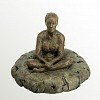


LIONEL SMIT, Repose #3
Bronze, 37 x 40 x 43 cm
Lionel Smit is best known for his contemporary portraiture executed through monumental canvases and sculptures. Perhaps more than anything else, Smit’s work is defined by a profound and ongoing dialogue between sculpture and painting.
A multidisciplinary artist, each of Smit’s works offers us an entry point into the variety and richness that lies beneath every face we encounter in life, whether applied in bronze or in paint. While retaining their austerity and meditative aesthetic, Smit’s figures remain highly charged with the emotive and gestural energy of his creative process.
Smit’s bronzes are created using the lost wax casting method. Patinas commonly available to artists working in bronze include natural browns, blacks and greens. However, given the importance of colour to Smit, he uses alternative methods that result in a unique fusion of intensely saturated patinas. Smit’s ability to manipulate the patination process, coupled with his focused enthusiasm for surface gradations, has allowed him to consistently push boundaries.
Smit’s process as an artist today remains adaptive, inventive, and physically engaging and he has achieved success internationally, from Hong Kong to London and New York.




PENELOPE STUTTERHEIME, Weaver I
Oil on canvas, 129.5 x 124.5 cm
Depicting inner landscapes has long been South African artist Penelope Stutterheime’s preoccupation. Drawing inspiration from dreams and the unconscious, her layered and textured oil paintings use impasto and intensely vibrant colour to create mesmerising abstract works.
Conveyed through hue and form, the images are a representation of transformation. Her paintings are a portrayal of her own inner spiritual processes, while also interrogating universal consciousness.
The daughter of a forester, Stutterheime developed her intense love for landscape as a child growing up in Newlands Forest, Cape Town. She studied part-time with the artist Simon Stone and the late Bill Ainslie, one of South Africa’s finest abstractionists, but aside from this is largely self-taught. She has participated in solo and group exhibitions consistently over the past thirty years, and her paintings are included in private and corporate collections around the world.
"My practice engages actively with layering the literal passage of time and formal artistic considerations onto one symbolic surface. The choice of colours represents my own mindscape; in turn I hope to reflect on larger
considerations, offering a reconnection and weaving together of humanity’s mindfulness and beyond."
- Penelope Stutterheime



PENELOPE STUTTERHEIME, Weaver IV
Oil on canvas, 55 x 60 cm
Depicting inner landscapes has long been South African artist Penelope Stutterheime’s preoccupation. Drawing inspiration from dreams and the unconscious, her layered and textured oil paintings use impasto and intensely vibrant colour to create mesmerising abstract works.
Conveyed through hue and form, the images are a representation of transformation. Her paintings are a portrayal of her own inner spiritual processes, while also interrogating universal consciousness.
The daughter of a forester, Stutterheime developed her intense love for landscape as a child growing up in Newlands Forest, Cape Town. She studied part-time with the artist Simon Stone and the late Bill Ainslie, one of South Africa’s finest abstractionists, but aside from this is largely self-taught. She has participated in solo and group exhibitions consistently over the past thirty years, and her paintings are included in private and corporate collections around the world.
"My practice engages actively with layering the literal passage of time and formal artistic considerations onto one symbolic surface. The choice of colours represents my own mindscape; in turn I hope to reflect on larger
considerations, offering a reconnection and weaving together of humanity’s mindfulness and beyond."
- Penelope Stutterheime



PENELOPE STUTTERHEIME, Weaver V
Oil on canvas, 120 x 120 cm
Depicting inner landscapes has long been South African artist Penelope Stutterheime’s preoccupation. Drawing inspiration from dreams and the unconscious, her layered and textured oil paintings use impasto and intensely vibrant colour to create mesmerising abstract works.
Conveyed through hue and form, the images are a representation of transformation. Her paintings are a portrayal of her own inner spiritual processes, while also interrogating universal consciousness.
The daughter of a forester, Stutterheime developed her intense love for landscape as a child growing up in Newlands Forest, Cape Town. She studied part-time with the artist Simon Stone and the late Bill Ainslie, one of South Africa’s finest abstractionists, but aside from this is largely self-taught. She has participated in solo and group exhibitions consistently over the past thirty years, and her paintings are included in private and corporate collections around the world.
"My practice engages actively with layering the literal passage of time and formal artistic considerations onto one symbolic surface. The choice of colours represents my own mindscape; in turn I hope to reflect on larger
considerations, offering a reconnection and weaving together of humanity’s mindfulness and beyond."
- Penelope Stutterheime






ANGUS TAYLOR, Being and Thinking
Bronze and tiger iron
"You can only write poetry in a language you know."
– Angus Taylor
Angus Taylor is known for his powerful, often monumental, sculptural works made from materials from his immediate environment – Belfast granite, red Jasper and the orange earth found near Johannesburg. Although he references traditional South African crafting techniques, his works are unmistakably contemporary. Taylor’s craftsmanship, bold and visionary approach and his original use of materials has resulted in many ambitious public and private commissions around the world.
Angus Taylor’s formidable knowledge of and affinity with stone and metals runs deep, fueled by endless research, experimentation and grappling with ancient materials – and by fiery processes in his foundry.




ANGUS TAYLOR, Deep Remembrance
Bronze and black banded chert, 122 x 45 x 33 cm
"You can only write poetry in a language you know."
– Angus Taylor
Angus Taylor is known for his powerful, often monumental, sculptural works made from materials from his immediate environment – Belfast granite, red Jasper and the orange earth found near Johannesburg. Although he references traditional South African crafting techniques, his works are unmistakably contemporary. Taylor’s craftsmanship, bold and visionary approach and his original use of materials has resulted in many ambitious public and private commissions around the world.
Angus Taylor’s formidable knowledge of and affinity with stone and metals runs deep, fueled by endless research, experimentation and grappling with ancient materials – and by fiery processes in his foundry.







ANGUS TAYLOR, Discordant Harmony Maquette
Bronze and hematite, 75 x 30 x 16 cm
"You can only write poetry in a language you know."
– Angus Taylor
Angus Taylor is known for his powerful, often monumental, sculptural works made from materials from his immediate environment – Belfast granite, red Jasper and the orange earth found near Johannesburg. Although he references traditional South African crafting techniques, his works are unmistakably contemporary. Taylor’s craftsmanship, bold and visionary approach and his original use of materials has resulted in many ambitious public and private commissions around the world.
Angus Taylor’s formidable knowledge of and affinity with stone and metals runs deep, fueled by endless research, experimentation and grappling with ancient materials – and by fiery processes in his foundry.


PHILIPPE UZAC, Fields III
gold leaf and oil on canvas, 85 x 115 cm
"Texture and patina are important elements in my work. But more essentially the laying bare of the past - looking for something like an unreachable truth - uncovering hidden layers of paint, is what drives me as an artist …
I look for an aesthetic in decay and try to capture it on canvas and on wood panels that I use as support to my work.
I reproduce the effects of time using all sorts of tools such as knives and spatulas, but also chemicals and waxes, sandpaper and glue. It is a gruelling and a very physical exercise, constantly scratching, rubbing and sanding off layers of paint.
It is a long process as the work consists of multi-layered artist oil paints - produced in my studio with pigments sourced in Burgundy - each layer needing to dry and be ‘worked out’ before the next one can be applied."
– Philippe Uzac





PHILIPPE UZAC, Vanishing Shapes I
OIL AND GOLD LEAF ON CANVAS, 85 x 115 cm
"Texture and patina are important elements in my work. But more essentially the laying bare of the past - looking for something like an unreachable truth - uncovering hidden layers of paint, is what drives me as an artist …
I look for an aesthetic in decay and try to capture it on canvas and on wood panels that I use as support to my work.
I reproduce the effects of time using all sorts of tools such as knives and spatulas, but also chemicals and waxes, sandpaper and glue. It is a gruelling and a very physical exercise, constantly scratching, rubbing and sanding off layers of paint.
It is a long process as the work consists of multi-layered artist oil paints - produced in my studio with pigments sourced in Burgundy - each layer needing to dry and be ‘worked out’ before the next one can be applied."
– Philippe Uzac



SHANY VAN DEN BERG, Intertwined II
Oil on canvas, 100 x 135 cm
Shany van den Berg’s practice centres on contemporary portraiture and figurative work. Her inspirations stems from her life as a woman, mother of four children and a
professional artist.
Renowned for her technical acumen, subtle symbolism and agility in shifting between portraiture, figurative, abstraction and sculptural work, she explores the critical contemporary themes of womanhood, identity, family, and connectedness to Mother Earth. Van den Berg’s portraiture is most often of women, whose features morph into a composite of the artist and her loved ones, serving as portals to narratives of sacrifice, struggle and ultimately transcendence. The references are delicate and ambiguous.
Van den Berg has worked as a full-time artist for almost thirty years. She is a threetime finalist in the BP National Portrait Award in the UK (now the Herbert Smith Freehills Portrait Award), as well as a threetime finalist in the South African Sanlam Portrait Award. Her practice includes painting on board, linen and found objects, drawing, sculpture, site specific installations, mixed media, three-dimensional work as well as poetry and music.




ELIZE VOSSGÁTTER, Ecdysis
beeswax and pigment on canvas, 160 x 80 cm
‘By observing the language of the natural world, we start to understand the patterns of existence.’
Elize Vossgätter’s work is concerned with our unnatural relationship to the natural environment.
Her primary medium is natural beeswax, which she soaks in chemicals, impregnates with synthetic pigment and then works onto the canvas using heat. The constant tension between the organic and inorganic is palpable. Gouging into the multilayered and multicoloured wax sediment – an exercise in carving – the outcome is a surface structure reminiscent of a relief: a testament to sensual organic forms which evoke the physical laws of the natural world, from which she draws her visual vocabulary. Ecdysis is the process of shedding the outer layer of the skin or exoskeleton.



BARBARA WILDENBOER, Pears Cyclopedia
Altered book (hand cut), 54 x 51 cm
Barbara Wildenboer is a South African artist who uses a combination of analog and digital processes to create work that mostly consists of collage, photo-and-paper construction, installation, digitally animated collage works, and book arts.
Her trademark ‘altered books’ function as narrative clues, intertexts or ‘subtitles’ accompanying the other works, referring to subject matter ranging from ancient history, archaeology and fractal geometry to psychoanalysis.
The altered book series 'Library of the Infinitesimally Small' and 'Unimaginable Large' (2011–present) was inspired by a short story by the Argentinian writer Jorge Luis Borges titled The Library of Babel. In this large-scale ongoing project she uses the library as a metaphor for the universe.
Barbara Wildenboer’s altered books breathe renewed life into previously prized objects that are disappearing into obsolescence in our digital age.
Barbara Wildenboer uses a combination of analogue and digital processes to create sculptural artworks that consist of collage, photo and paper-construction as well as digitally animated photographic sculpture. Wildenboer also creates delicately-cut altered books which often contain maps, atlases and scientific subject matter, sometimes using images from the book as central elements to her pieces. Imagery and words become components of the larger designs, as she crafts new visual narratives from the raw material.


BARBARA WILDENBOER, Pocket Oxford Dictionary
Altered book (hand cut), 54 x 51 cm
Barbara Wildenboer is a South African artist who uses a combination of analog and digital processes to create work that mostly consists of collage, photo-and-paper construction, installation, digitally animated collage works, and book arts.
Her trademark ‘altered books’ function as narrative clues, intertexts or ‘subtitles’ accompanying the other works, referring to subject matter ranging from ancient history, archaeology and fractal geometry to psychoanalysis.
The altered book series 'Library of the Infinitesimally Small' and 'Unimaginable Large' (2011–present) was inspired by a short story by the Argentinian writer Jorge Luis Borges titled The Library of Babel. In this large-scale ongoing project she uses the library as a metaphor for the universe.
Barbara Wildenboer’s altered books breathe renewed life into previously prized objects that are disappearing into obsolescence in our digital age.
Barbara Wildenboer uses a combination of analogue and digital processes to create sculptural artworks that consist of collage, photo and paper-construction as well as digitally animated photographic sculpture. Wildenboer also creates delicately-cut altered books which often contain maps, atlases and scientific subject matter, sometimes using images from the book as central elements to her pieces. Imagery and words become components of the larger designs, as she crafts new visual narratives from the raw material.
FLORIAN WOZNIAK, Skater
Bronze, 56 x 22 x 33 cm
Working primarily in bronze, Florian Wozniak's smooth, figurative forms feel rooted to the earth and convey a powerful serenity. His sculptures are by turns tender and endearing, playful and witty; his characters often evoking pathos or humour.
Wozniak seeks transcendence through his work, a release from the constraints of the corporeal. This counterpoint is explored in the interplay between mass, weight, volume, and structure on the one hand, and fluidity, motion and grace on the other.
Optimism is implicit in every piece Wozniak sculpts and is palpable in the finished object. It is no surprise that he identifies so strongly with the sentiment of 20th century, Italian sculptor, Arturo Martini, when he said, ‘In this Babylon, where everyone has lost [their] senses, my sculpture could bring them some joy in its clarity and vibrancy.’





FAITH XLVII, Ex Astra
carved and inked wood, 145 x 121 cm
Liberty Du, who is widely recognised as Faith XLVII, is a multi-disciplinary South African artist. Her journey into art began on the streets of South Africa in 1997, as a young graffiti writer taking on the name Faith47 (the number being a reference to her grandmother’s numerological theorem). In 2006, Liberty began on a nomadic journey which has brought her to create works in over 39 countries.
Translating to ‘from the stars,’ Ex Astra is a wooden ensemble comprised of twelve
hand-carved geometric impressions. These blocks show the stains of the printmaking process, serving as the foundational layers forming Faith’s broader woodcut series, reflecting an intuitive visual exploration that aligns with the cyclical nature of the twelve months of the year. Drawing on ritualistic practices, Ex Astra invokes an ancient awareness of the phases that shape human experience. The geometric forms within the work function as talismans, echoing transcendental states, embodying an abstraction that meets at the crossroads of time and space.




































































Specialists in contemporary art from South Africa. Established in 1913. South African artists are part of the global conversation. We seek to make their voices heard.

